Pam Marlin May 2016 & 2021
Photos of Magnolia Plantation Bed & Breakfast (Baird Mansion} updated April 2021 after author's visit.
 The Baird Mansion in 1896 with Mary Baird on the porch.
Photo provided by current owners of the Magnolia Plantation Bed & Breakfast,
Joe and Cindy Montalto, who received it from the Baird family.
The Baird Mansion in 1896 with Mary Baird on the porch.
Photo provided by current owners of the Magnolia Plantation Bed & Breakfast,
Joe and Cindy Montalto, who received it from the Baird family.
With a nod to a Victorian style architecture with a slightly haunted look, the Baird Mansion at 309 Southeast 7th Street, formerly 505 Roper Avenue SE, is as impressive today as it must have been at the turn of the century in Gainesville, Florida. This historic area of Gainesville was part of the original town plan of 1854 which extended east of Sweetwater Branch in 1857 by Bailey's Addition, followed by Roper's Addition in 1876-77. Built in the ornate Second French Empire style which is unique in the Southeast, the mansion (and property) has had many owners and renters, but one particular family, the Bairds, occupied the mansion for nearly 70 years. 7
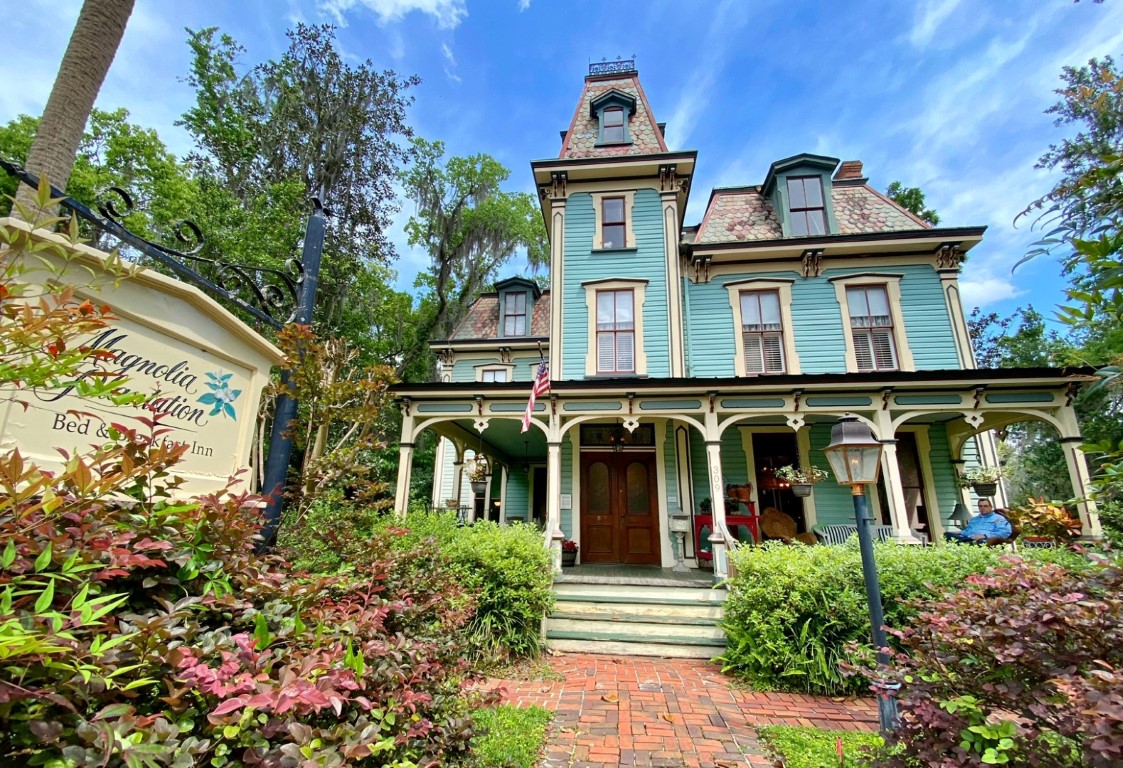 Magnolia Plantation Bed & Breakfast (Baird Mansion). P Marlin 2021
Magnolia Plantation Bed & Breakfast (Baird Mansion). P Marlin 2021
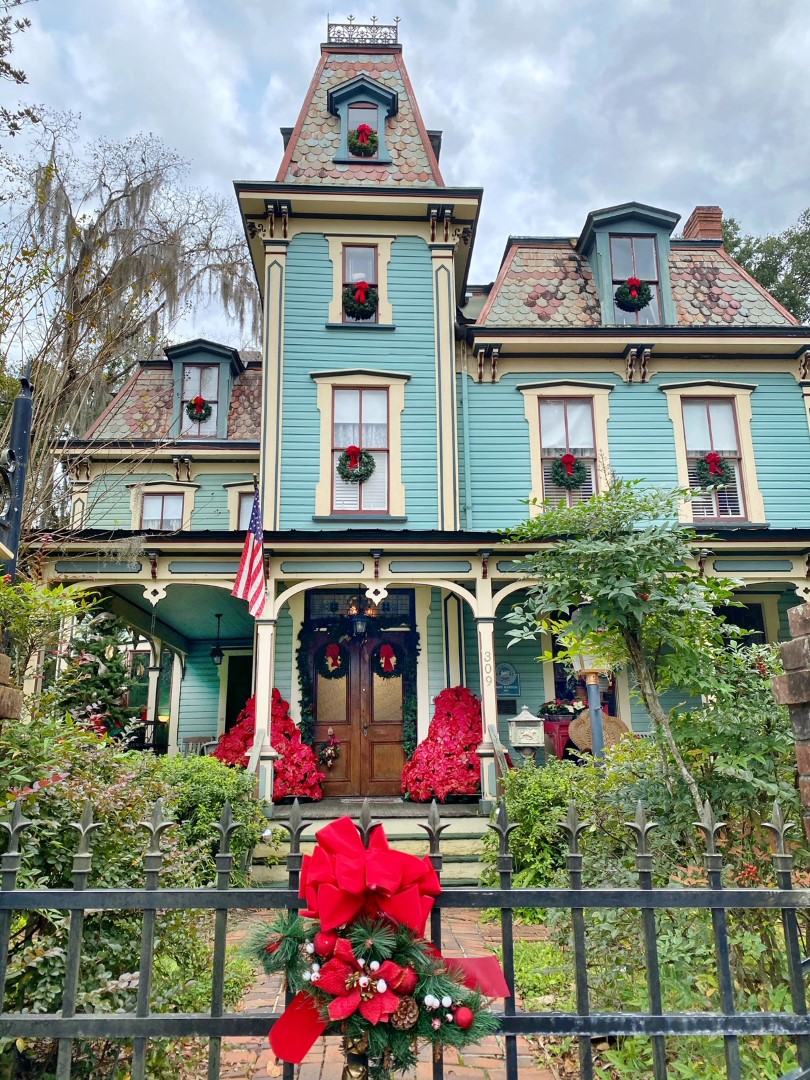 The Magnolia Plantation Bed & Breakfast decorated for Christmas. P. Marlin 2020
The Magnolia Plantation Bed & Breakfast decorated for Christmas. P. Marlin 2020
Before the mansion was built, property deeds show a long list of owners, starting in 1864 when the property was purchased by J.H. Roper from Tillman Ingram. In 1876, the property sold at public auction as part of the property of J.H. Roper to B.S. Forster. In 1882, Forster sold it to Maximilian D. Berlitz of Boston, Massachusetts, originator of the Berlitz Language schools, who, in 1883, sold it to George Ferrell, a local grocery store owner, for $2,000 (it is referred to as the "Miaskoski Place" on the deed). The property was sold again in 1885 to Malinza Harriet Williams for $3250 who passed it on to her son J. Dudley Williams, who is believed to have built the mansion. A plaster medallion found inside the mansion is inscribed May 7, 1886, potentially indicating the approximate time it was built. Finally, in 1900, the mansion was sold to Emmet Joseph Baird and his wife, Mary. The mansion remained in the Baird family until 1966, having been deeded to a Baird daughter after the death of Mary. 1
The following is an excerpt from the United States Department of Interior's National Register of Historic Places which describes in detail the Baird Mansion's French Second Empire architectural style, which was common in France during the period of Napoleon III. The 5,400 square foot Baird Mansion includes fourteen rooms, ten fireplaces, and seven bathrooms.
"The Second Empire style is characterized principally by its distinctive mansard roof, a dual or double pitched structure usually having dormer windows on the steep lower slope, molded cornices, and bracketed eaves. The name and forms of the Second Empire Style are derived from its extensive use in France during the reign of Napoleon III (1852-70), France's Second Empire. Exhibitions in Paris in 1855 and 1867 helped popularize the style in England from which it spread to the United States. The boxy roof line, named for the 17th century French architect Francois Mansart, was considered particularly functional because it permitted a full upper story of usable attic space. The Second Empire style was used for many public buildings in America as well as residences.
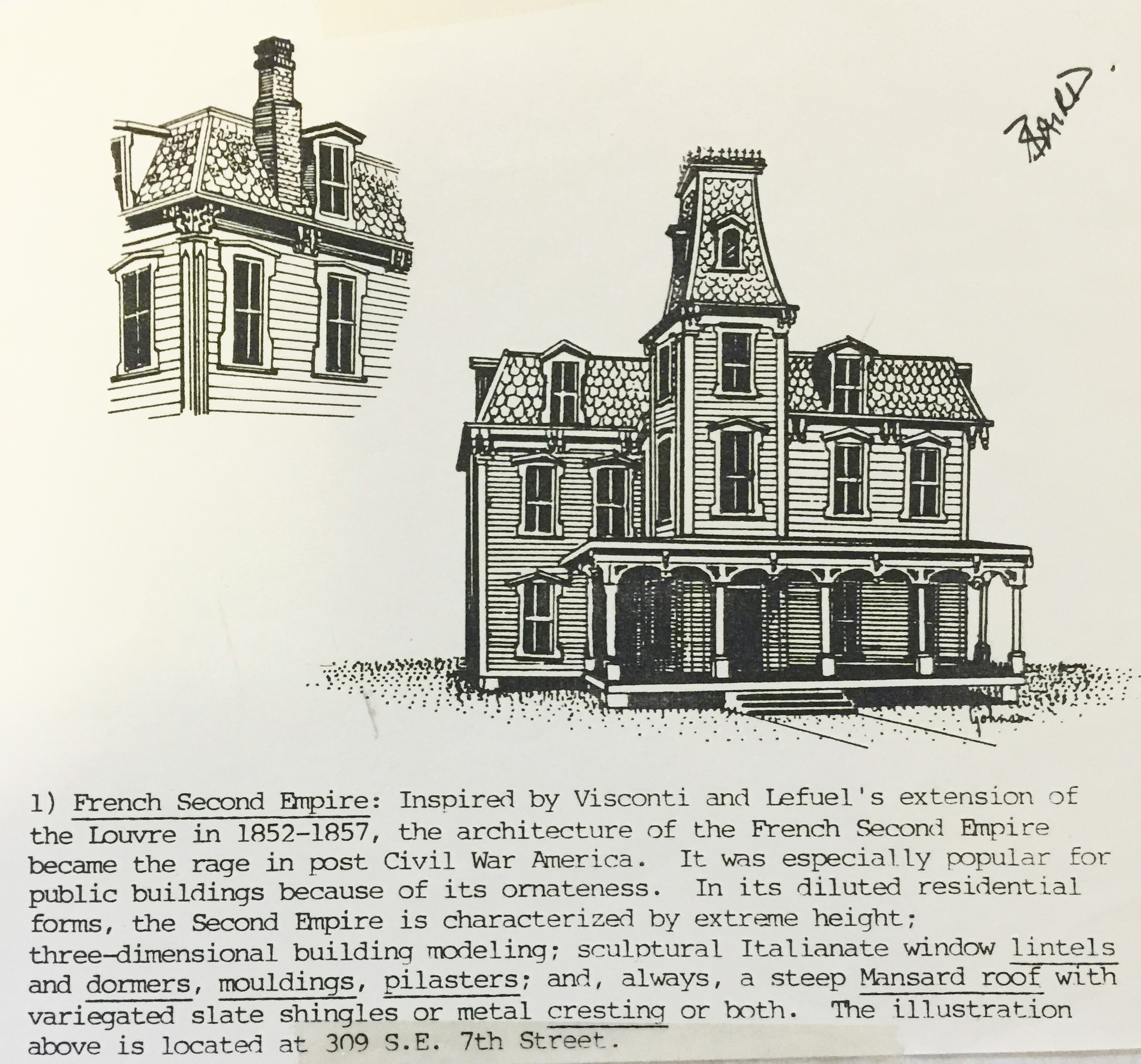 Matheson Museum Archive
Matheson Museum Archive
As is the case with about 30 percent of Second Empire houses, the Baird Mansion has a tower that soars over the main block of the building. It is placed slightly off-center on the main facade and has a mansard roof with small dormer windows on each side. The house is unusual in that most irregular plan Second Empire houses lack towers. The Baird Mansion also makes use of many decorative details typical of both the Second Empire and Italianate styles, which were contemporaries of one another. The windows have pedimented and chamfered frames, and the full-width veranda on the facade features chamfered posts with arched brackets and center drops between the porch bays. There is also a two-story bay window on the south elevation of the house. In fact, it is often only the mansard roof that distinguishes a Second Empire house from an Italianate example." 7
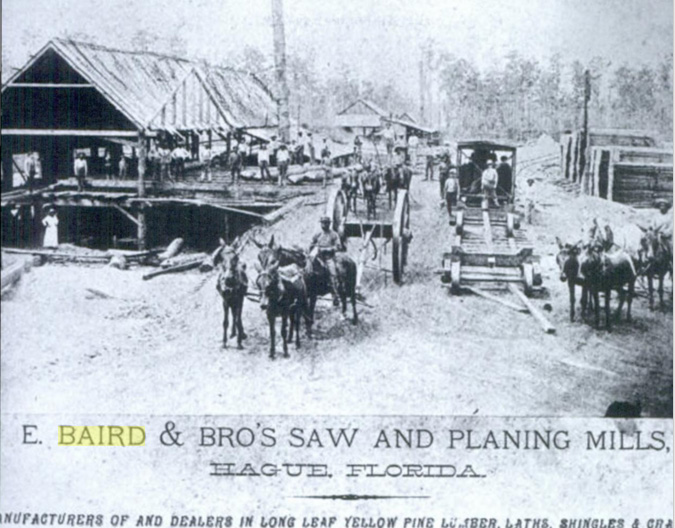 E. Baird & Bros. Saw and Planing Mills, Hague, Florida
E. Baird & Bros. Saw and Planing Mills, Hague, Florida
Originally from the midwest, Emmet J. and his brother, Eberle, moved to Florida in 1881 to become co-owners of the E. Baird & Bros. Saw and Planing Mill in Hague which sold and produced "longleaf yellow pine lumber, crates, laths and shingles. The mill became plagued with problems. A devastating fire, a building collapse, and a boiler explosion that killed an employee persuaded Eberle to go elsewhere, so he sold his interest in the business to his brother Emmet and moved to Gainesville. Eberle would go on to establish the successful Baird Hardware company, which did not permanently close until 1981, as well as the Baird Theater).
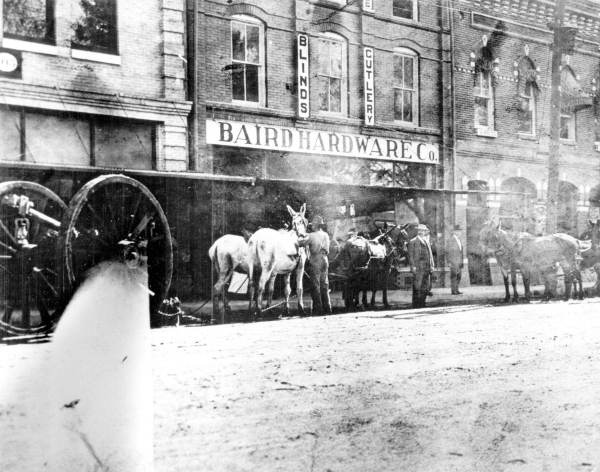 Baird Hardware, Gainesville. Florida State Archives.
Baird Hardware, Gainesville. Florida State Archives.
Emmet, his wife Mary, and their children, followed Eberle to Gainesville and established a successful business of their own, a vegetable basket and crate factory called the "Standard Crate Company" located near the Plant Railway depot south of Gainesville. The Standard Crate Company made boxes for shipping fruit and vegetables which were brought to Gainesville for distribution during the city's heyday. Emmet prospered in Gainesville. His crate company was successful and he purchased a large home and a sawmill in Santa Fe (1903). His financial success caused some of the local town folks to wonder if his wealth was due to a circulating rumor suggesting that Emmet had found an old pirate's treasure on the Suwannee River. A treasure he had reportedly searched for a couple years earlier. 3 4 6 10
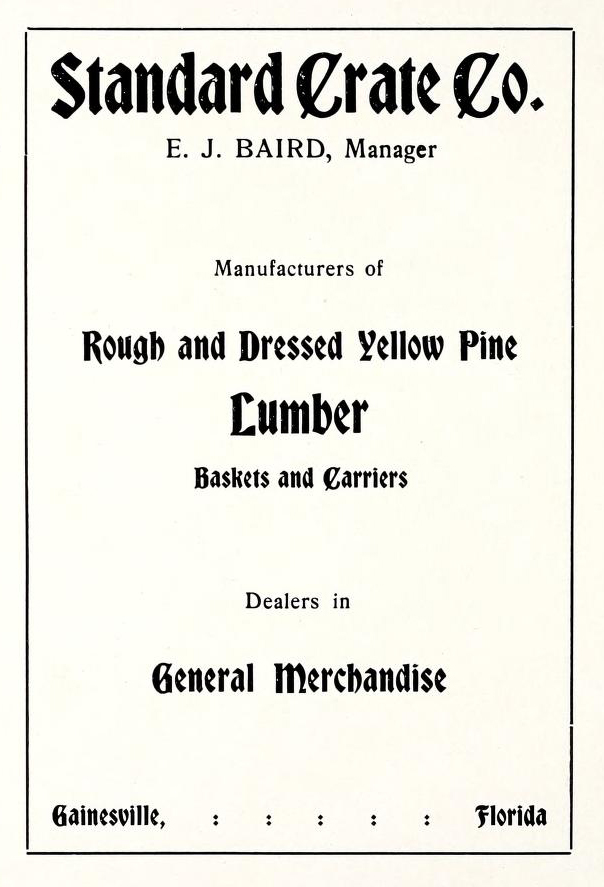 Standard Crate Advertisement in The Alachuan.
Standard Crate Advertisement in The Alachuan.
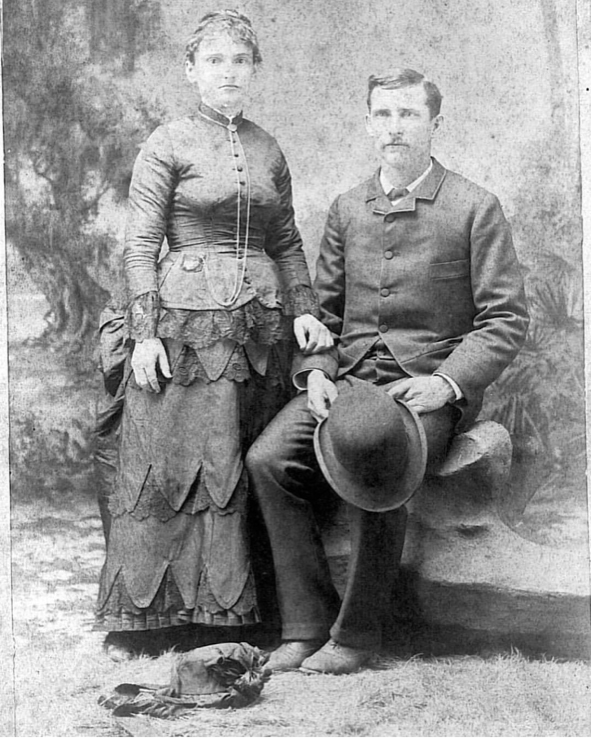 Emmet J. Baird and his wife.
Emmet J. Baird and his wife.
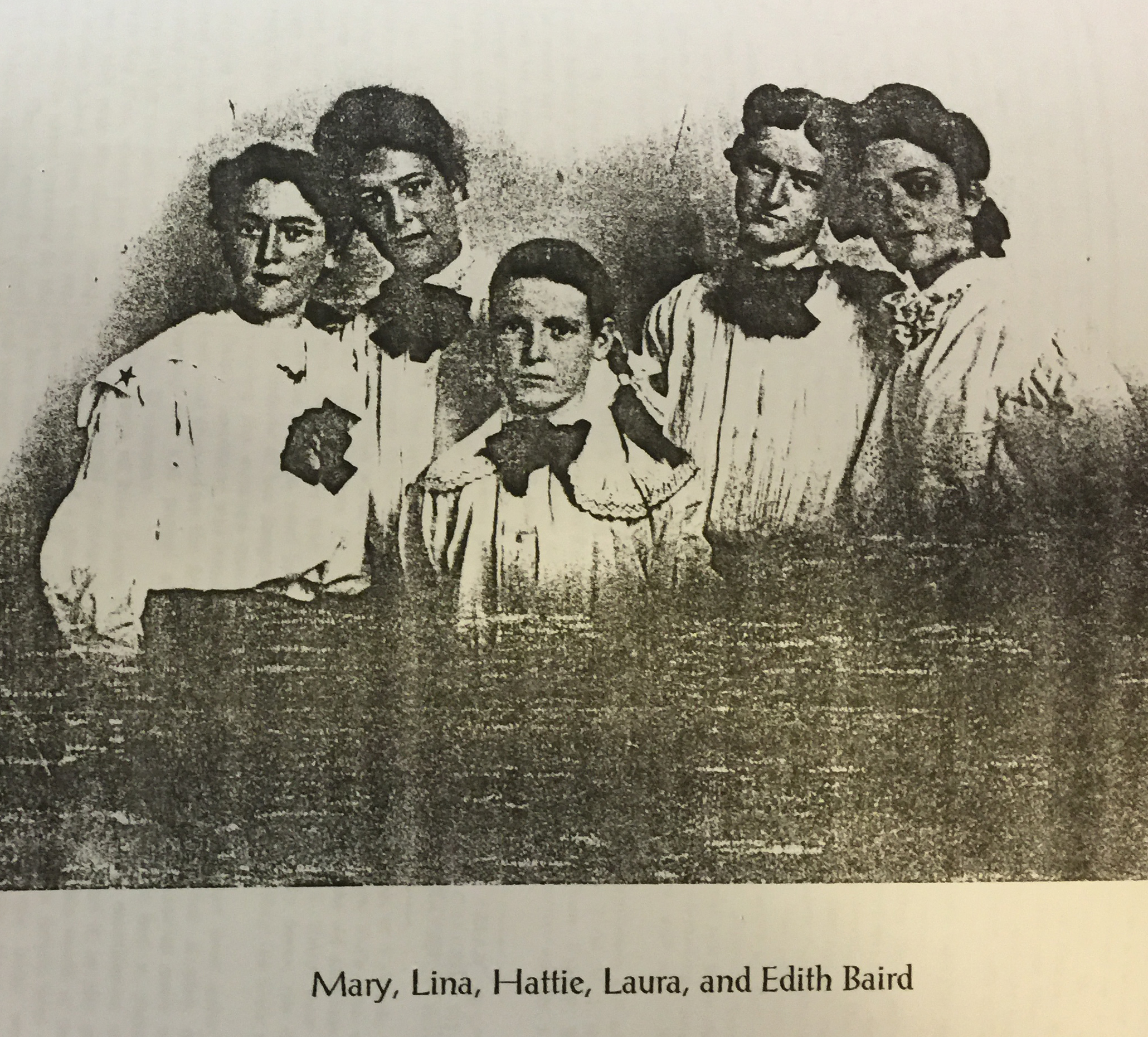 The Baird daughters. The Baird Mansion Historical Review11
The Baird daughters. The Baird Mansion Historical Review11
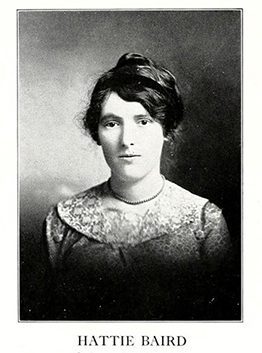 In 1900, Emmet and Mary bought a house that would later be known as the Baird Mansion,
and settled down to raise their large family.
The 1900 Gainesville census
records the family as Emmet (head), Mary A. (wife), Ervine (son), Calvin (son),
Edith B. (daughter), Laura (daughter), Lena (daughter), Mary (daughter)
and Hattie (daughter, photo left). The Baird children were all well educated and attended local schools,
including
Gainesville High School, to which Hattie Baird was part of the yearbook staff (The Alachuan 1913)
and East Florida Seminary (pre University of Florida).
The Baird daughters received a good secondary school education, which was rare for girls at the time.
The oldest Baird daughter, Edith, graduated from the East Florida Seminary (EFS document). Laura received a degree from the Boston Conservatory of
Music. Lena (seated second from right in 1908 Senior Class photo) and Hattie (photo left) both attended the Florida
Female College in Tallahassee. Mary attended the East Florida Seminary and the Curry School of Expression in Boston.8 One son, Emmet died young, and another son,
Ira, also attended East Florida Seminary.
In 1900, Emmet and Mary bought a house that would later be known as the Baird Mansion,
and settled down to raise their large family.
The 1900 Gainesville census
records the family as Emmet (head), Mary A. (wife), Ervine (son), Calvin (son),
Edith B. (daughter), Laura (daughter), Lena (daughter), Mary (daughter)
and Hattie (daughter, photo left). The Baird children were all well educated and attended local schools,
including
Gainesville High School, to which Hattie Baird was part of the yearbook staff (The Alachuan 1913)
and East Florida Seminary (pre University of Florida).
The Baird daughters received a good secondary school education, which was rare for girls at the time.
The oldest Baird daughter, Edith, graduated from the East Florida Seminary (EFS document). Laura received a degree from the Boston Conservatory of
Music. Lena (seated second from right in 1908 Senior Class photo) and Hattie (photo left) both attended the Florida
Female College in Tallahassee. Mary attended the East Florida Seminary and the Curry School of Expression in Boston.8 One son, Emmet died young, and another son,
Ira, also attended East Florida Seminary.
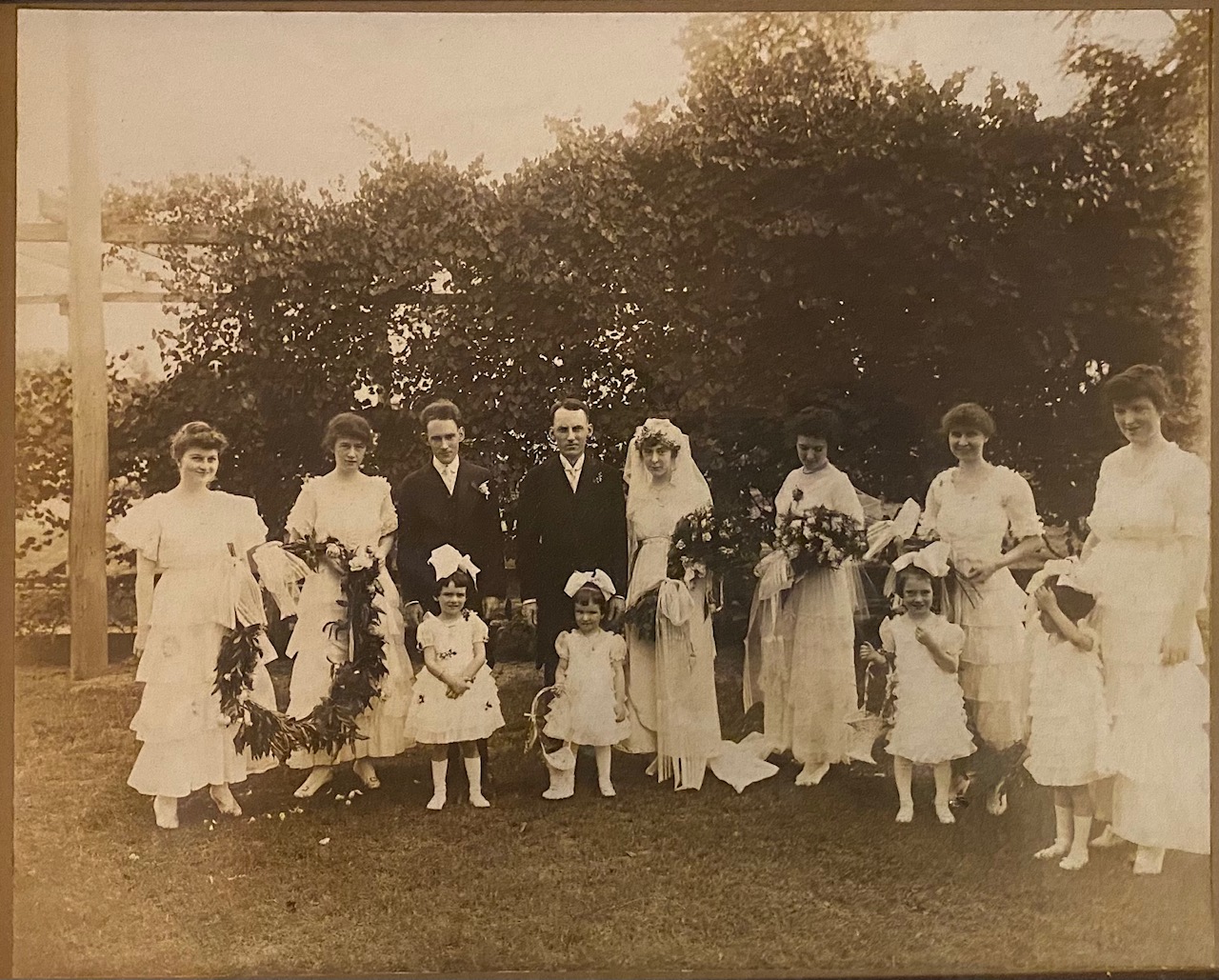 The wedding party of Mary Baird and Thomas M. Shackelford, June 22, 1915, in the
yard of the Baird Mansion. Magnolia Plantation Display.
The wedding party of Mary Baird and Thomas M. Shackelford, June 22, 1915, in the
yard of the Baird Mansion. Magnolia Plantation Display.
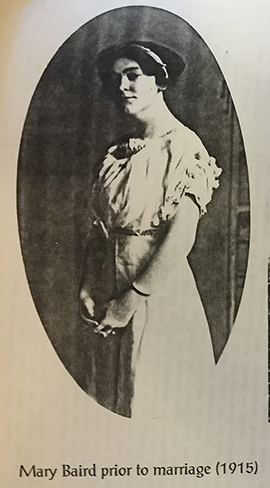 Edith (marriage record),
Lena (marriage record), and
Mary, (photo left, marriage record), were all married in the Baird Mansion.
The following is an excerpt from an article in The Daily Sun on June 23, 1915, eloquently describing the wedding of Mary to Thomas M. Shackleford of Tampa
(full article11):
Edith (marriage record),
Lena (marriage record), and
Mary, (photo left, marriage record), were all married in the Baird Mansion.
The following is an excerpt from an article in The Daily Sun on June 23, 1915, eloquently describing the wedding of Mary to Thomas M. Shackleford of Tampa
(full article11):
"A wedding of special interest in Gainesville took place yesterday afternoon at the home of Mr. and Mrs. E.J. Baird, when their daughter, Mary, became of the bride of Mr. Thomas M. Shackleford, Jr., of Tampa. The lower floor of the Baird residence was beautifully and tastefully decorated for the occasion with palms, ferns, and cut flowers. In the drawing room where the ceremony took place a white and green motif was effectively carried out with large graceful palm branches, white lilies and quantities of asparagus fern, the details of the decorative scheme being most artistic.
Preceding the bride were the dainty little flower girls Misses Clara Nelle and Hazel Lee Baird, who carried artistic baskets twined with fern and filled with white rose petals. They wore pretty little dresses of white organdie trimmed in tiny ruffles and big bows of white ribbon on their hair.
Miss Baird's wedding dress was very charming and girlish creation of white crepe meteor, with the bodice of Princess lace. It was made round length with long court traine fastened to the shoulders. Her veil was arranged in a ruche at the top of her head and a coronet of orange blossoms and pearls encircled her brow. Her bouquet was of brideroses with a shower of valley lilies and roses."10 12
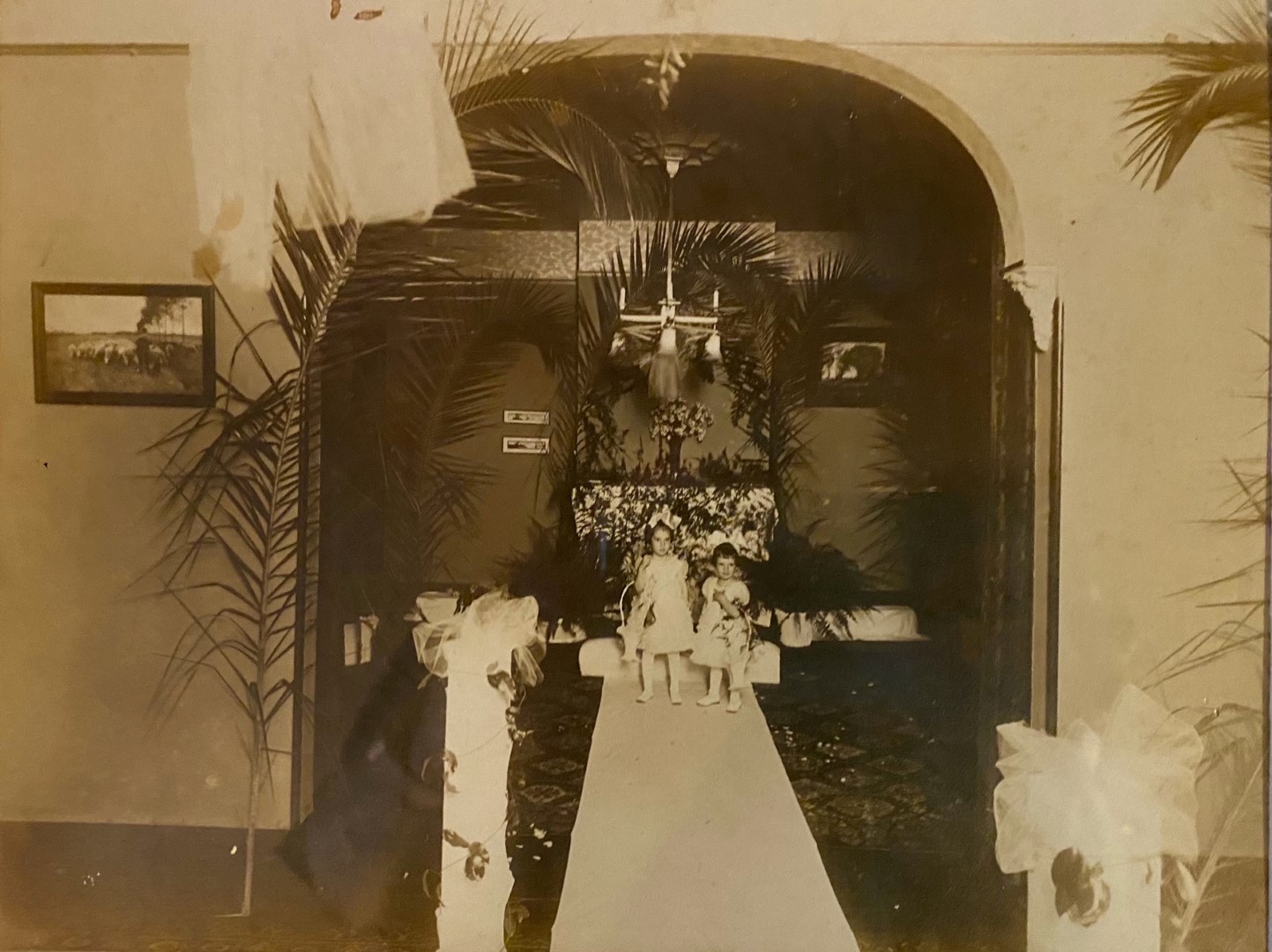 Clara Nell Baird and Hazel Lee Baird, at the altar
of Mary Baird's wedding inside the Baird Mansion, June 22, 1915. Clara died in the Gardenia room of the mansion at the
age of six. Magnolia Plantation Display.
Clara Nell Baird and Hazel Lee Baird, at the altar
of Mary Baird's wedding inside the Baird Mansion, June 22, 1915. Clara died in the Gardenia room of the mansion at the
age of six. Magnolia Plantation Display.
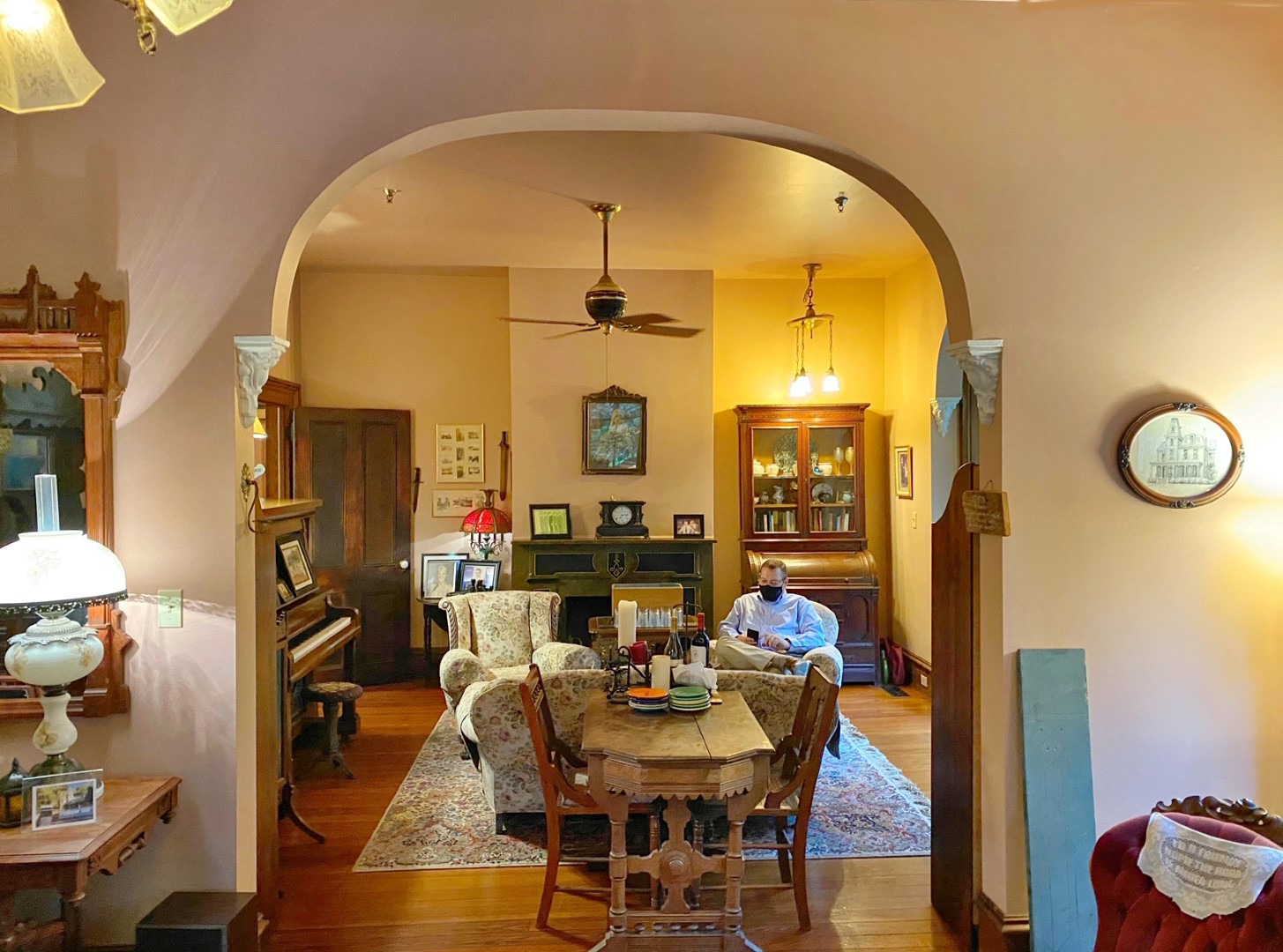 The same view as the photo above. Photo taken while staying
at the Magnolia Plantation Bed & Breakfast. P Marlin 2021
The same view as the photo above. Photo taken while staying
at the Magnolia Plantation Bed & Breakfast. P Marlin 2021
In a letter2 written to Wm. Everett Warinner, E. Raymond Turner, grandson of Emmet Baird, fondly recalls his memories of the house:
"When I was growing up in the house, it was the only dwelling on the half-block bounded by Roper, Arlington and Palmetto. There was a barn approximately where the garage now stands, somewhat further back, behind the barn and outhouse. South of the barn and closer to the main house there was a small building we called the "gas house." This had contained machinery for producing acetalyne gas, used to light the house originally. In the early 1900's combination gas electric fixture were installed, since Gainesville's first electric plant was somewhat unpredictable. Some of these fixtures may still be in the house. The marbelized slate mantels with Victorial decorations were stolen when the house was vandalized after Mrs. Ashmore became ill and moved to Tampa. Outbuilding also included a "Cook's House" to the southeast corner of the main house, shaded by a huge chinaberry tree which was struck by lightning when I was about ten years old, and two large chicken houses well back on the lot. There was a huge mulberry tree in front of the barn. And the driveway ran through a grapearbor more than a hundred feet long, heavily laden with grapes every summer. My grandfather and his brother liked exotic plants and there were a number of palm trees and fruits which were uncommon in the Gainesville area both in the gardens and in the parkway which divided the street in front of the house.
The neighborhood was one of the better ones. The north half of the block was occupied by Col. Dell's house. Although by the mid '20's this had been divided into apartments and the back half of the lot sold to Dr. Lake, Chairman of the University of Florida's history department. The Roper half of the next block north was occupied by the Swearingen house. Both it and the Dell house were of about the same vintage as the Baird house, possibly a little younger. I believe they are both still standing but in sadly altered shape." 2
In 1966, Hattie Baird Ashmore, daughter of Emmet and Mary, sold the mansion to Richard L. Faircloth. In 1970, the mansion sold to Edward Rolf, and then to Jeff Meldon and Dean Lowman in 1971. The mansion continued to pass through various owners and renters and it was during this time that the condition of the house was neglected. Its deterioration was described in "The Baird House and Family:" 3
"In the succeeding decades (after the family sold the house) the house passed through the hands of numerous owners, most of whom used it as rental property, and the house deteriorated badly. Screens hung losely from windows, vines and debris filled the yard and pieces of slate fell from the roof. During the 1970's it became a hippie meeting place and transients started fires in the building. Massive house parties attracted 300-400 people who often danced on the roof of the front porch."
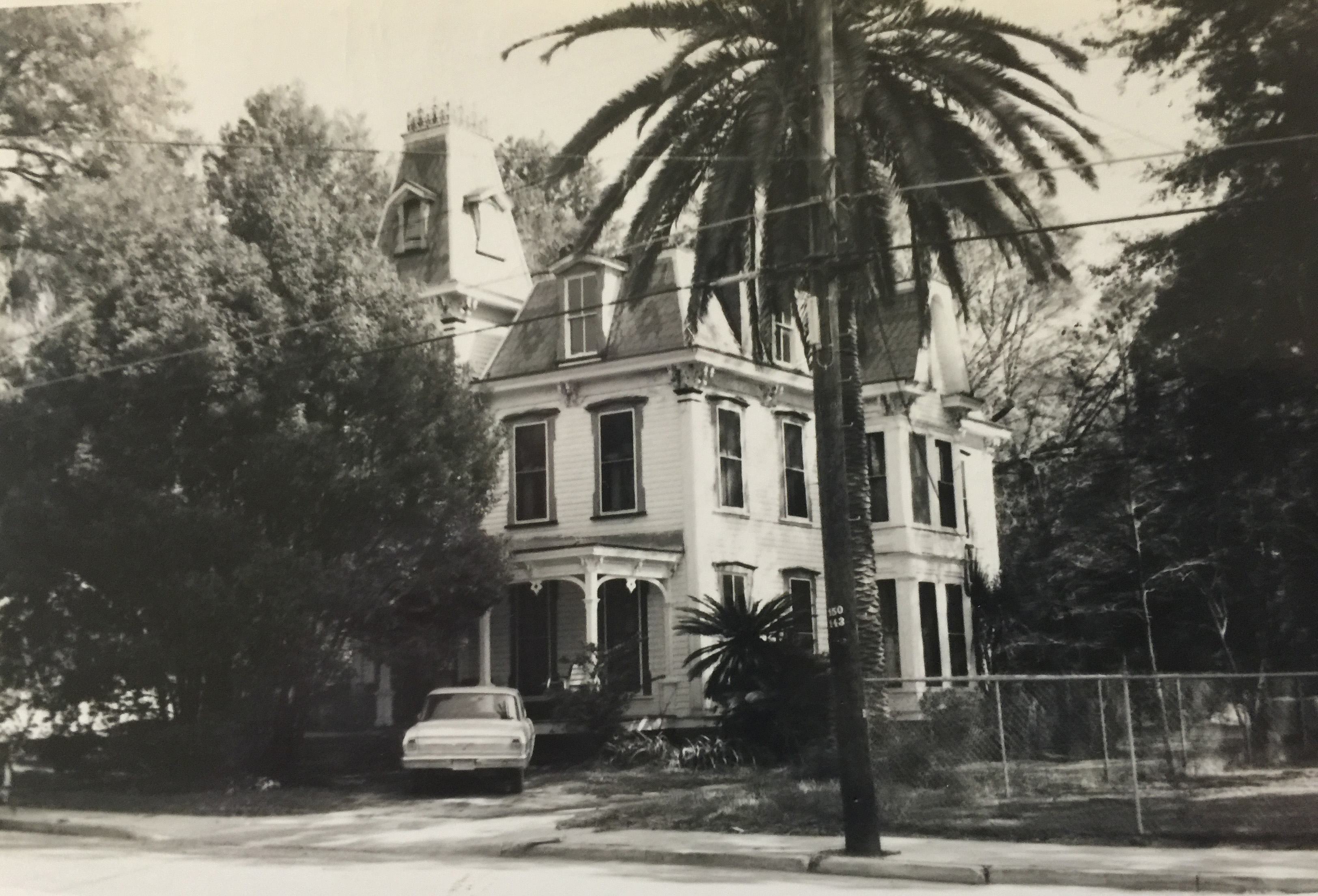 Baird Mansion date unknown (Matheson Museum)
Baird Mansion date unknown (Matheson Museum)
In 1990 Cindy and Joe Montalto decided to buy the mansion and restore it as a bed and breakfast inn. At the time, four students were living in the house, in amongst the peeling paint and plaster. According to Cindy Montalto, there was "enough furniture for 15 people, not to mention seventeen potted bananas trees indoors, painted vines, a giant lizard and peace signs decorating the walls." 3 The restoration took up to a year of hard work and included replacing the plumbing lines, wiring, gas, central air conditioning and the addition of a fire sprinkling system. The restored mansion opened to guests in May 1992.
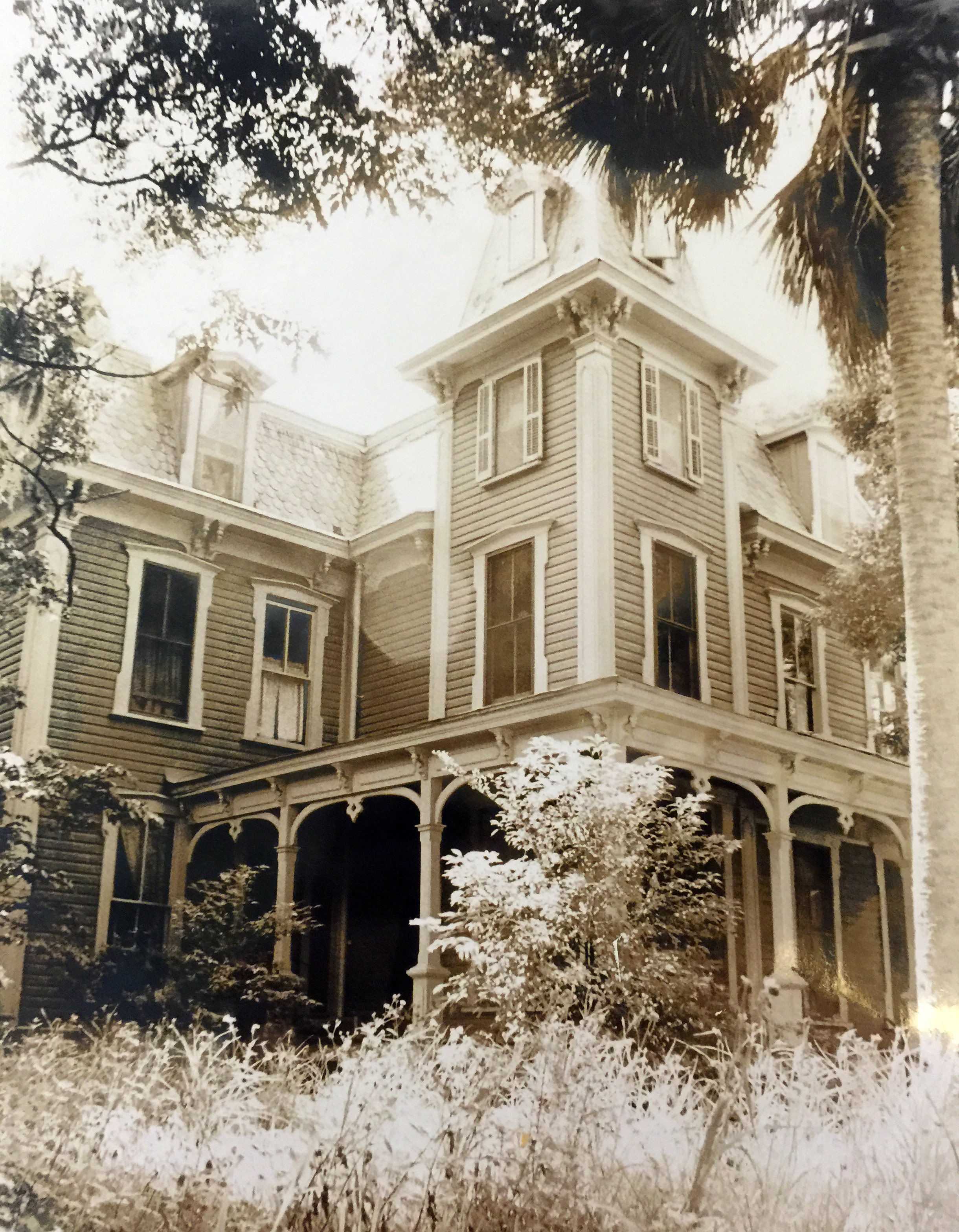 Photo, date unknown. Matheson Museum Archive
Photo, date unknown. Matheson Museum Archive
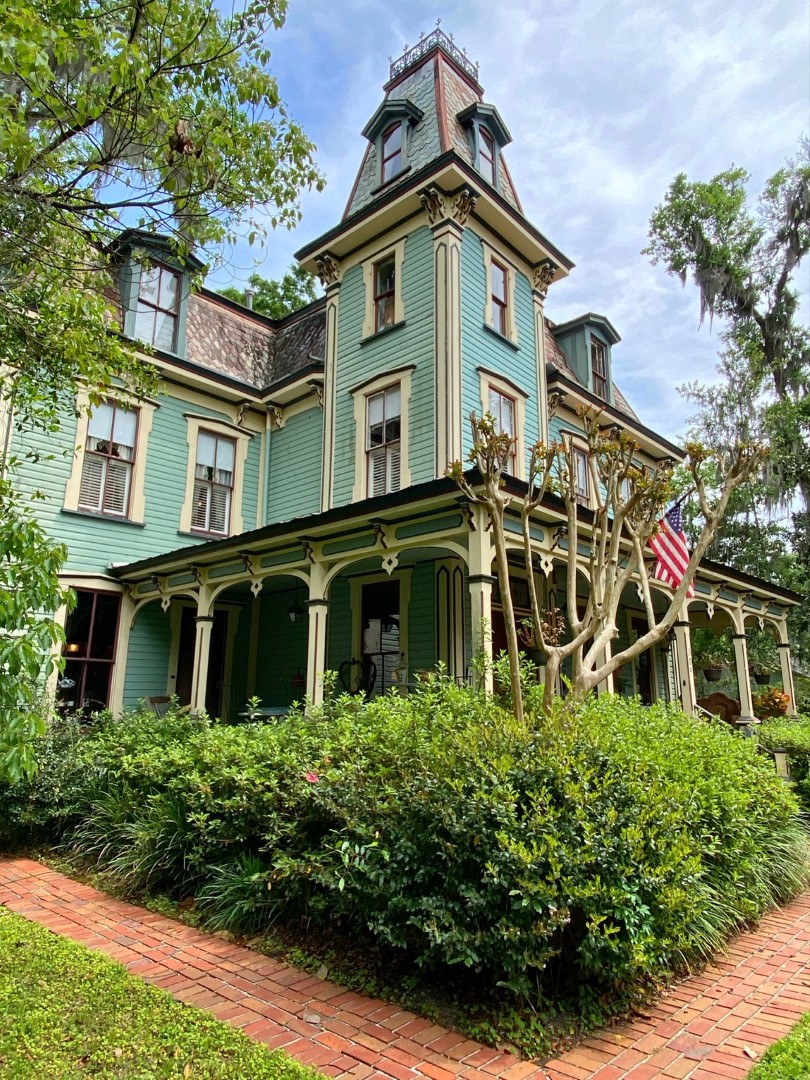 Magnolia Plantation Bed & Breakfast. P. Marlin 2021
Magnolia Plantation Bed & Breakfast. P. Marlin 2021
Still serving guests as a bed and breakfast inn in 2021, the Magnolia Plantation Bed & Breakfast (Baird Mansion) continues to embrace the past. There are two parlors, one for ladies and one for gentlemen. The mahogany staircase leads to the second floor where guests bedrooms have antique dressers, high beds and claw-foot tubs. There are many antiques in the mansion including a 100 year old parlor organ, original fireplace mantels, an original shaving mirror, and cypress doors. The most precious antique, however, is a tea set that belonged to the first Mary Baird and was donated to the current owners, Joe and Cindy Montalto, as a mansion warming gift by a Baird granddaughter.11 The Montaltos document and share their journey of buying and renovating the mansion in a blog13 they maintain on their Magnolia Plantation website.
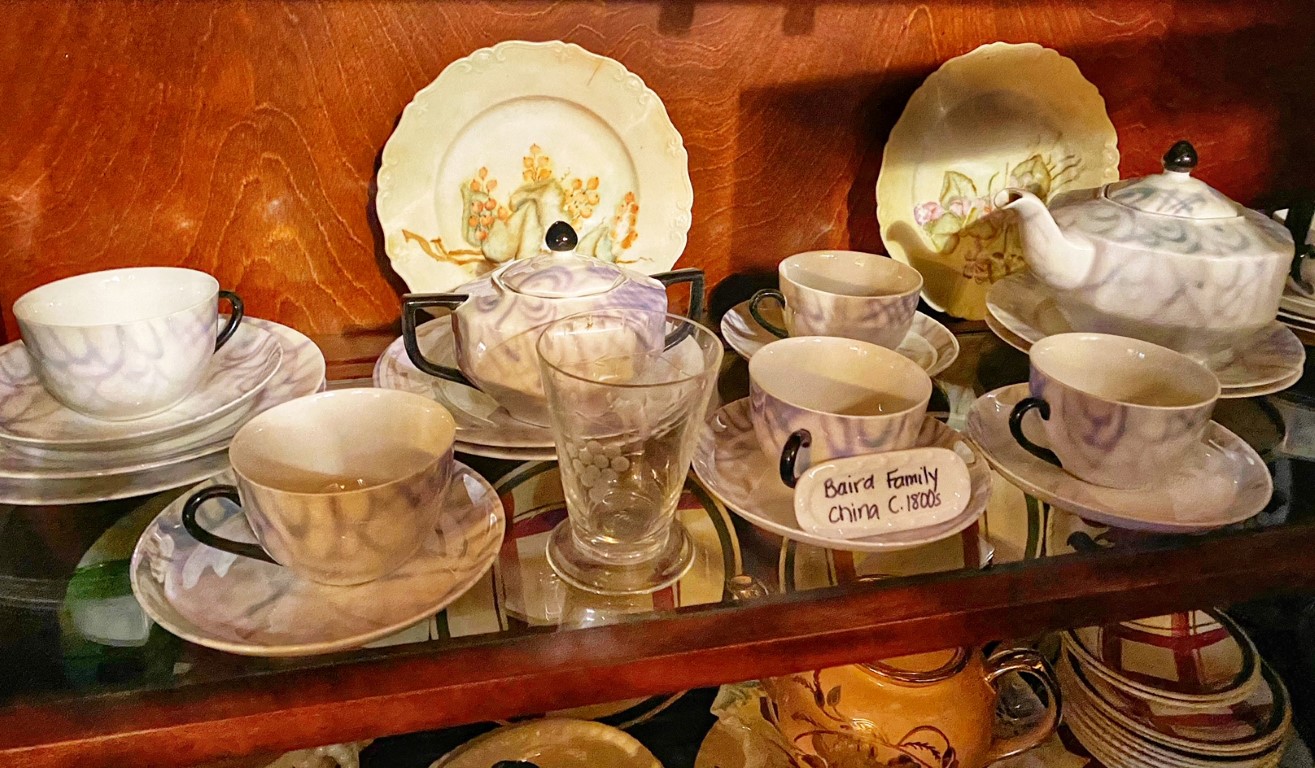 Baird family china located in the Magnolia Plantation Bed & Breakfast. P Marlin 2021
Baird family china located in the Magnolia Plantation Bed & Breakfast. P Marlin 2021
According to legend, Fowler's Bluff, located near Chiefland on the Suwannee River, is the site of treasure buried by 1800's privateer, Jean Lafitte. According to a Saturday Evening Post article dated June 2, 1945, Emmet Baird, one of the first to search for the treasure, may have found actually found some of it. There was a rumor that Baird found the treasure allowing him to invest in various business ventures and buy one of the nicest homes in Gainesville.
The following is an excerpt from Suwannee: River of Treasure, by Howard M. Duffy:
"The Fowler's Bluff story originated in 1897, when Emmett Baird befriended an elderly stranger, who was near death. Baird arranged a cot in a nearby shack for the ailing stranger and provided him with food. Nevertheless, the man's final hours were numbered. On his deathbed he confided to Baird that, as a pirate, he had participated in the burial of a huge amount of loot at Fowler's Bluff. Then, from beneath his blanket the dying man withdrew a rough map of the cache site, which he presented to Baird for his kindness. This map indicated three oak trees in a line, ten yards apart. Baird was told that chests of treasure were buried ten feet towards the river from each tree - about ten feet deep.
Now bitten by the "gold bug," Baird, with Orie Freeman, Joe Curry and other laborers, journeyed to the bluff and started digging a deep hole. Curry later stated Baird had permitted him to see the old pirate's map that showed three large oak trees. Curry also recalled that inked directions on the back of the map stated treasure was buried at three separate locations. This pick and shovel project was a laborious operation, hampered by treacherous quicksand that continually flowed into the pit as rapidly as the men could shovel. Finally, Baird ordered construction of a wooden cofferdam. At a 15-foot depth a large crowbar struck a solid object. More probing indicated it might be a chest, but the guicksand refused to release the object. So, Baird drove to Chiefland, where a blacksmith made him some grappling hooks.
With the aid of the hooks and a sturdy block and tackle, a chest was raised and placed in a wagon. After paying the laborers, Baird and Freeman drove away. Their destination was Gainesville, where the contents of their chest were placed in a bank vault. Did Baird actually recover a huge treasure? Well, consider this. Shortly after the above episode, he sold his marginal sawmill, established a bank, stocked the largest hardware store in Central Florida and purchased a large office building in Gainesville. He was now a millionaire!
Many authorities believe Baird recovered only a portion of the Fowler's Bluff trove."

 According to a Saturday Evening Post article dated June 2, 1945,
Emmet Baird, one of the first to search for the treasure, may have actually found the treasure. on June 2, 1945,
The Suwannee Treasure Hunt, to which the following excerpt was taken.
According to a Saturday Evening Post article dated June 2, 1945,
Emmet Baird, one of the first to search for the treasure, may have actually found the treasure. on June 2, 1945,
The Suwannee Treasure Hunt, to which the following excerpt was taken.
"As Baird pried, the object seemed to sink deeper and deeper into the almost fluid sand. Fearful that it would get beyond reach, he called Joe Curry to come down and help him estimate how large and heavy it was. Joe says that he was able to feel all around it, and to determine that it was encased in something like rough cement, and was about three feet, six inches long, two feet wide and one and one half feet thick. There was high excitement on the Bluff at this discovery. When it was decided that the object could not be raised without additional tools, Baird had the men stand guard while he rushed back to Hardee Town—by that time called Chiefland—where a blacksmith fashioned a set of grappling tongs to hook around the box. A scaffold was erected over the excavation and Curry went down into the liquid sand with a rope tied around his middle and hooked the jaws of the grapple around the object. Then, with two mules hitched to the hoisting rope, Curry stood on top of it to keep it steady and gave the signal to hoist away. Slowly, the sand began yielding its hold with a sucking sound. All concerned, even Mrs. Curry, were standing on the brink waiting to see what they felt must be millions spilled before their eyes. Suddenly, however, the hoisting rope parted and Joe Curry and the treasure were both dropped with a splash into the pit. Joe barely managed to cling to the rough plank platform to avoid being sucked under by the quicksands. The box sank from sight.
Baird and Freeman were filled with almost frantic despair on losing what they visualized as certain wealth just when it seemed within their grasp. Curry had been thoroughly frightened by his experience, and, though not a man generally susceptible to local superstitions, he admits now that he thought some curse, pirate or otherwise, was protecting whatever was buried there. All this happened during the third week after Baird arrived at the Bluff, and Curry was anxious to drop his part of the partnership and get back to a paying job. At this point, Baird offered him ten dollars for his share of whatever was found, and the privilege of working on a daily basis, while Mrs. Curry was to continue boarding them. The offer was accepted on the spot.
A large crowbar revealed that the chest had sunk down to a fifteen-foot level and was at least temporarily resting there. Everyone set to work building a crude cofferdam around the hole, going down below the chest's level. Without adequate equipment for such a job, they had their difficulties. It was six more weeks before they had the cofferdam completed and had dipped up watery sand until the chest was less than two feet below sand-and-water level. Both Baird and Freeman were at a high state of excitement again.
One night they worked until after one o'clock, and when Baird came in, he dropped the remark in a casual way that he was going to quit. Then he went into Freeman's room where the two men talked for more than an hour in a low tone. At daylight, Baird had his wagon hitched, and before the sun was up he, Freeman and old Bob drove off with nothing but a most perfunctory leave. Shovels, picks, the grapple and all other equipment were left there. Just what Baird got out of that hole there by the Suwannee probably will never be known, unless he left records that his descendants will not reveal or discuss today. But that he did get something."
Though some believe there is treasure to be found buried at the Baird Mansion today, the Montaltos, despite extensive restorations, have reportedly never found any treasure.
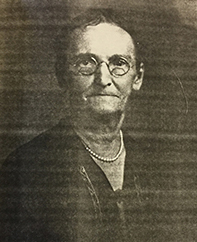 During his time in
Gainesville, Emmet Baird continued the crate business which he ran
successfully until his death in 1925. He died in the Magnolia Suite
of the Baird Mansion (Obituary11).
His wife Mary, (photo left11) died in 1948 (Obituary11).
The Baird mansion then passed to daughter, Hattie Baird Ashmore, who
sold it in 1966.
During his time in
Gainesville, Emmet Baird continued the crate business which he ran
successfully until his death in 1925. He died in the Magnolia Suite
of the Baird Mansion (Obituary11).
His wife Mary, (photo left11) died in 1948 (Obituary11).
The Baird mansion then passed to daughter, Hattie Baird Ashmore, who
sold it in 1966.
Unfortunately, three of the Baird children died at a young age. So, Emmet died at age two. Daughter, Lena, a teacher at Gainesville High School, died in 1916. Laura, a talented musician who became a nurse, died of Spanish Influenza during her service in the First World War (WWI registration card). In October 1918, there was an article posted in social events describing Laura's story. Son Calvin (Ira) died in 1963 (obituary). Several members of the family are buried in Evergreen Cemetery in Gainesville, Florida.
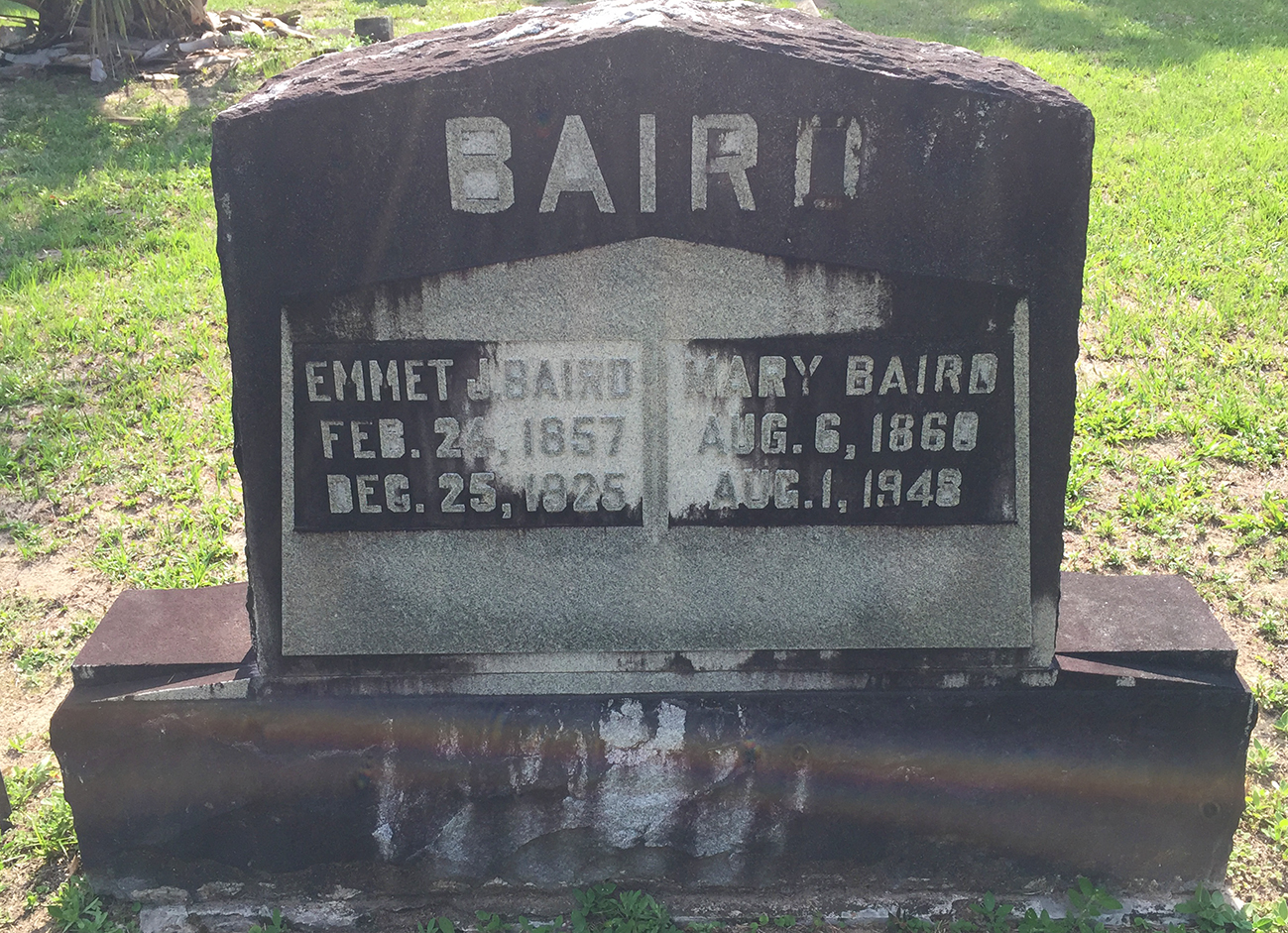 Emmet and Mary Baird, Evergreen Cemetery, Gainesville, Florida. P. Marlin 2016
Emmet and Mary Baird, Evergreen Cemetery, Gainesville, Florida. P. Marlin 2016
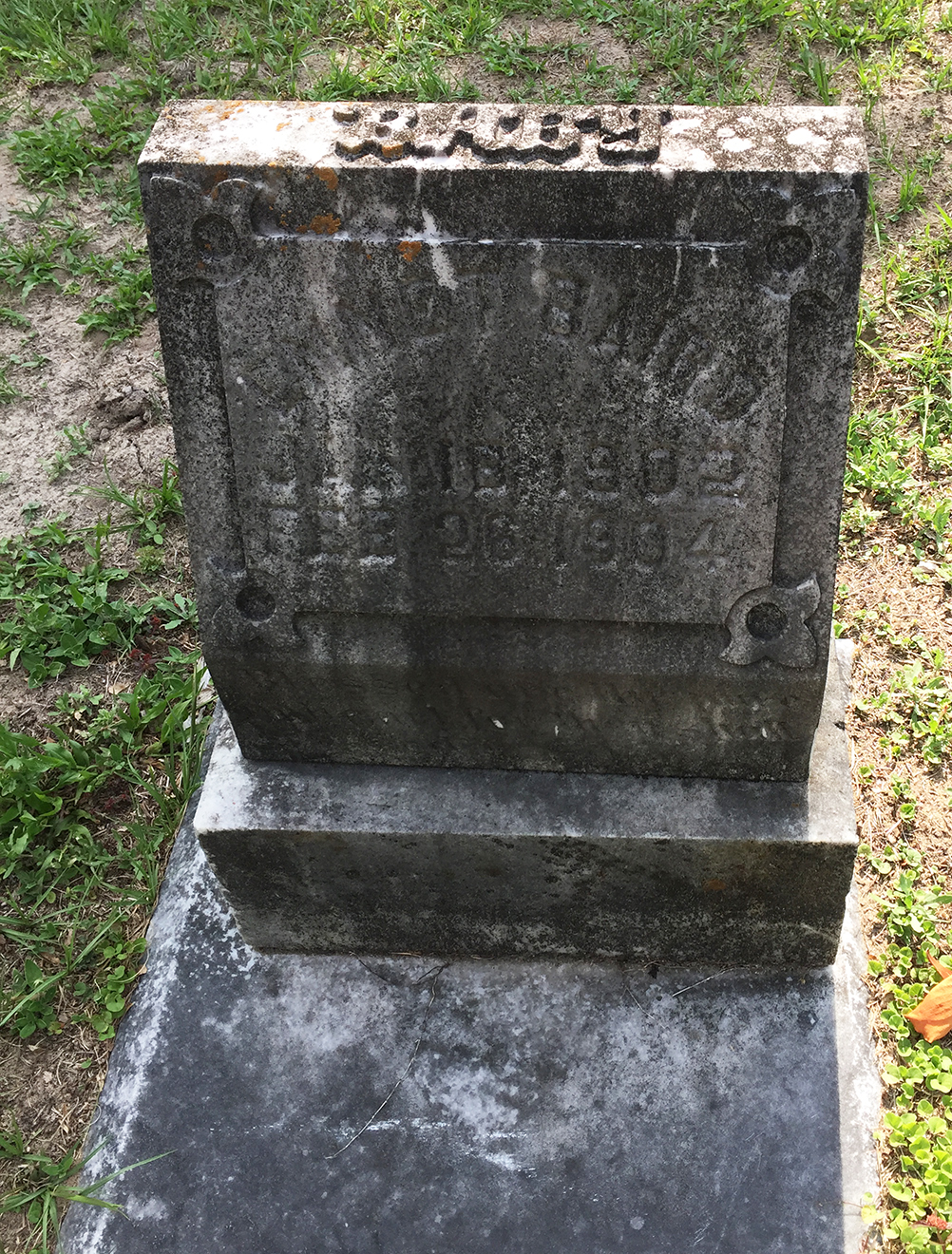 Emmet, baby son of Emmet and Mary Baird, Evergreen Cemetery, Gainesville, Florida. P. Marlin 2016
Emmet, baby son of Emmet and Mary Baird, Evergreen Cemetery, Gainesville, Florida. P. Marlin 2016
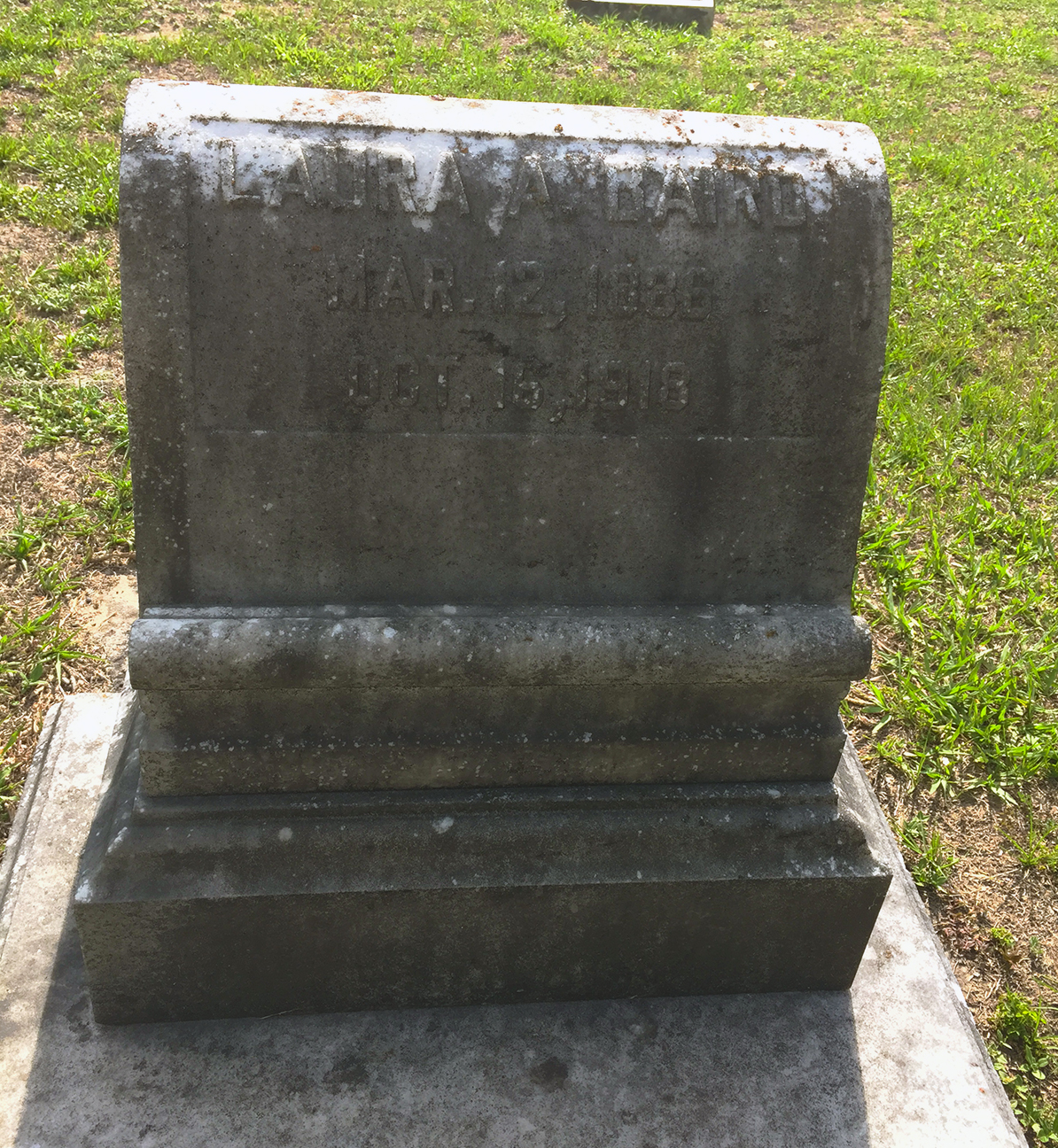 Laura Baird, daughter of Emmet and Mary, Evergreen Cemetery, Gainesville, Florid. P. Marlin 2016
Laura Baird, daughter of Emmet and Mary, Evergreen Cemetery, Gainesville, Florid. P. Marlin 2016
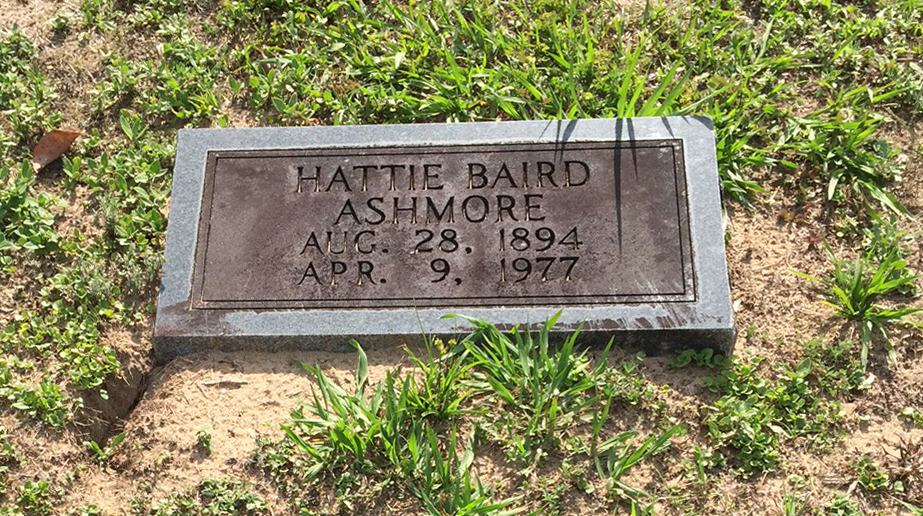 Hattie Ashmore Baird, daughter of Emmet and Mary, Evergreen Cemetery, Gainesville, Florida. P. Marlin 2016
Hattie Ashmore Baird, daughter of Emmet and Mary, Evergreen Cemetery, Gainesville, Florida. P. Marlin 2016
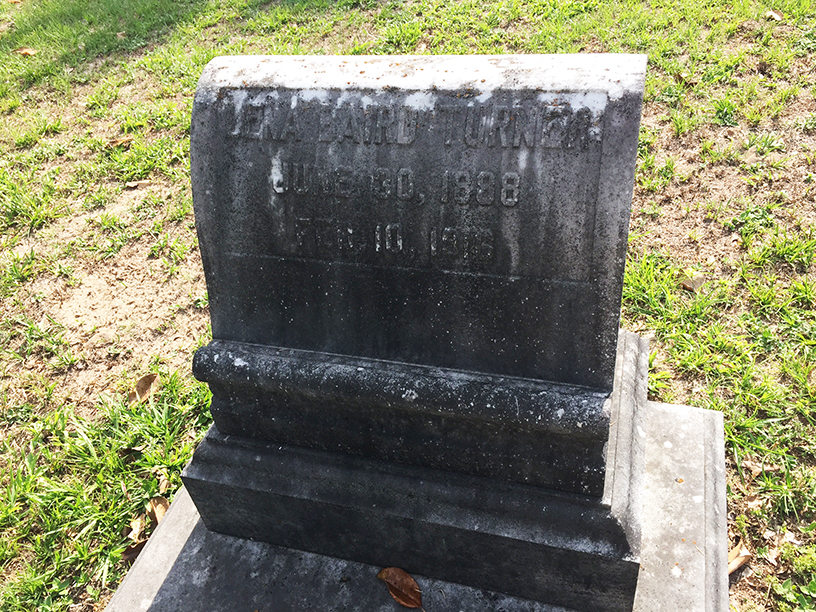 Lena Baird, daughter of Emmet and Mary, Evergreen Cemetery, Gainesville, Florid. P. Marlin 2016
Lena Baird, daughter of Emmet and Mary, Evergreen Cemetery, Gainesville, Florid. P. Marlin 2016
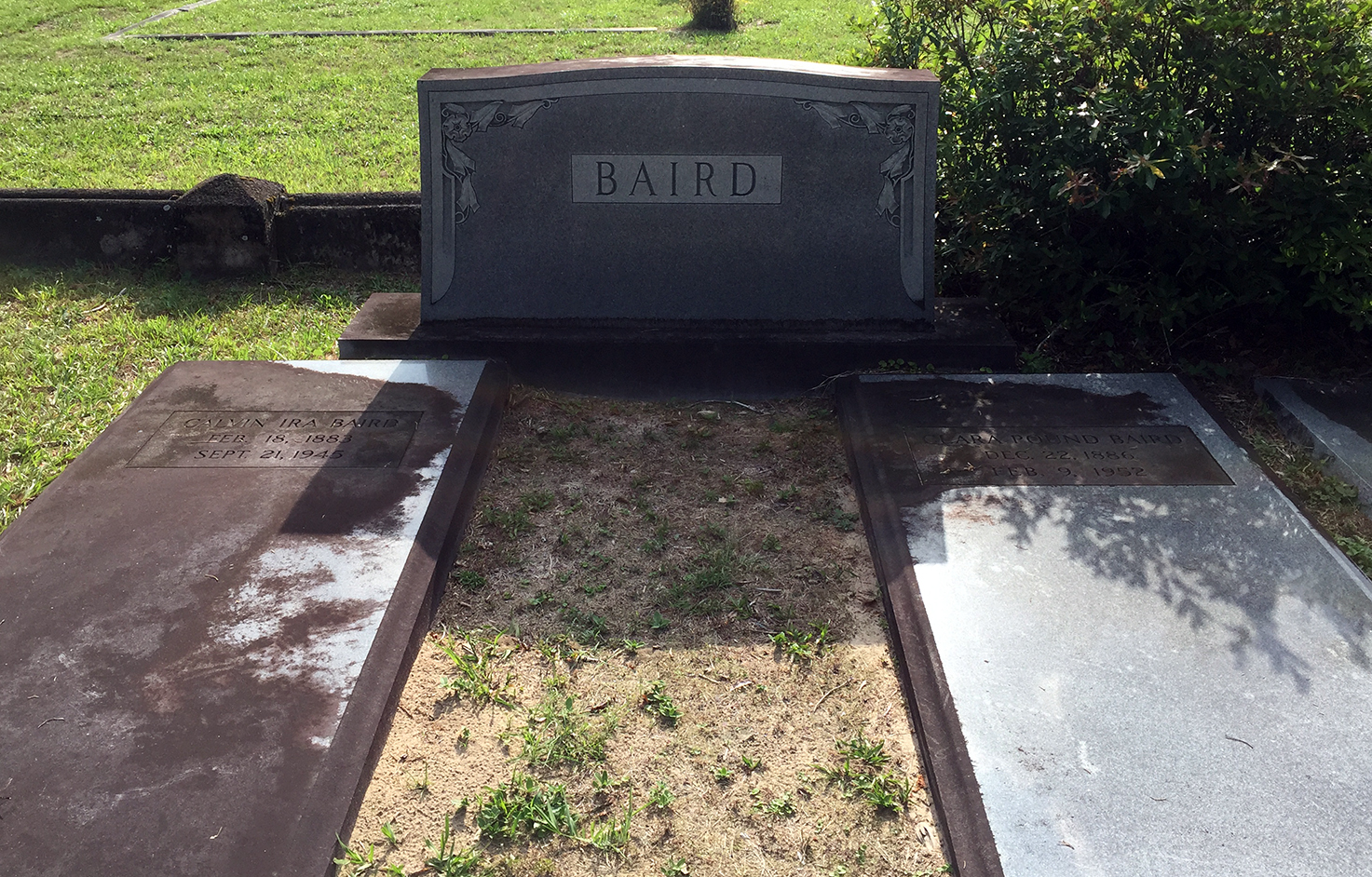 Calvin Ira, son of Emmet and Mary, and his wife Clara Pound Baird, Evergreen Cemetery, Gainesville, Florid. P. Marlin 2016
Calvin Ira, son of Emmet and Mary, and his wife Clara Pound Baird, Evergreen Cemetery, Gainesville, Florid. P. Marlin 2016
The following photos are from the author's first stay at Magnolia Plantation in April 2021. There's no better way to experience history than to stay in a 135 year old mansion whose family was an important part of Gainesville's early story. So many structural elements of the mansion remain, the front porch, the floors, the staircase, the windows and their wood framing, the doors, fireplace mantels, and lighting fixtures. According the mansion innkeeper, the Baird Mansion was the first to have lighting and plumbing in Gainesville. The restorers have ensured that a visit to Baird Mansion is a journey into the past.
 From the Gentleman's Parlor window to the front porch.
P Marlin 2021
From the Gentleman's Parlor window to the front porch.
P Marlin 2021
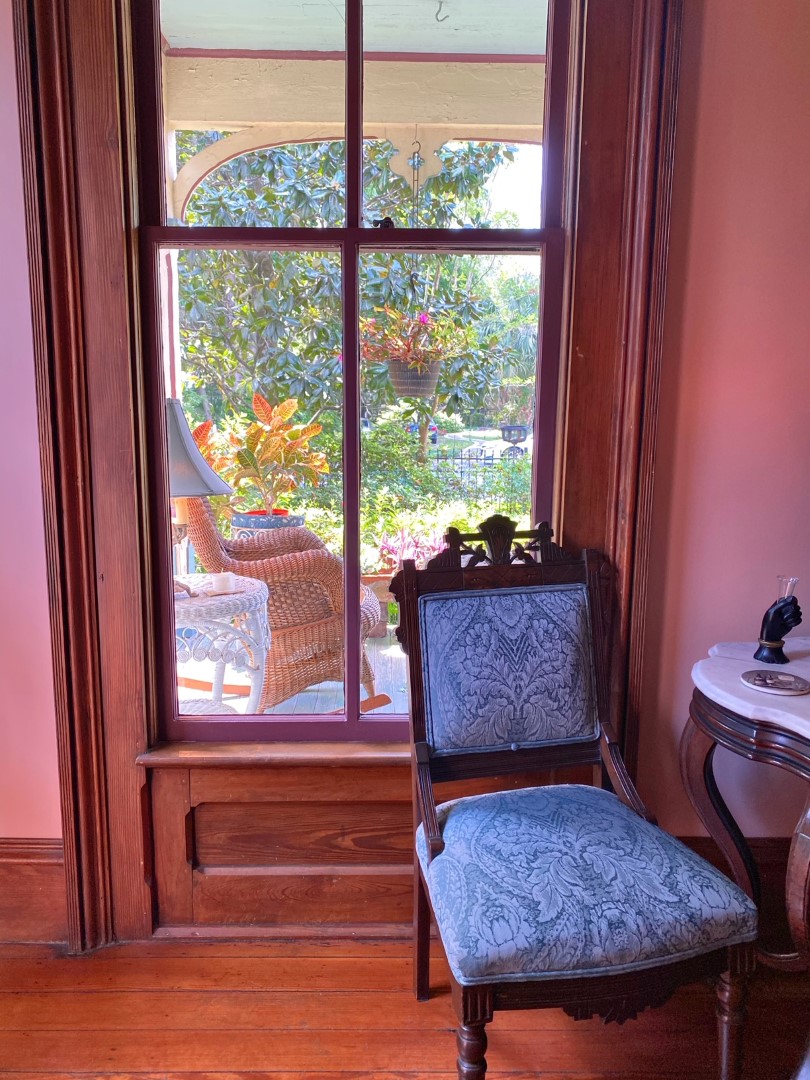 The Gentleman's Parlor window.
P Marlin 2021
The Gentleman's Parlor window.
P Marlin 2021
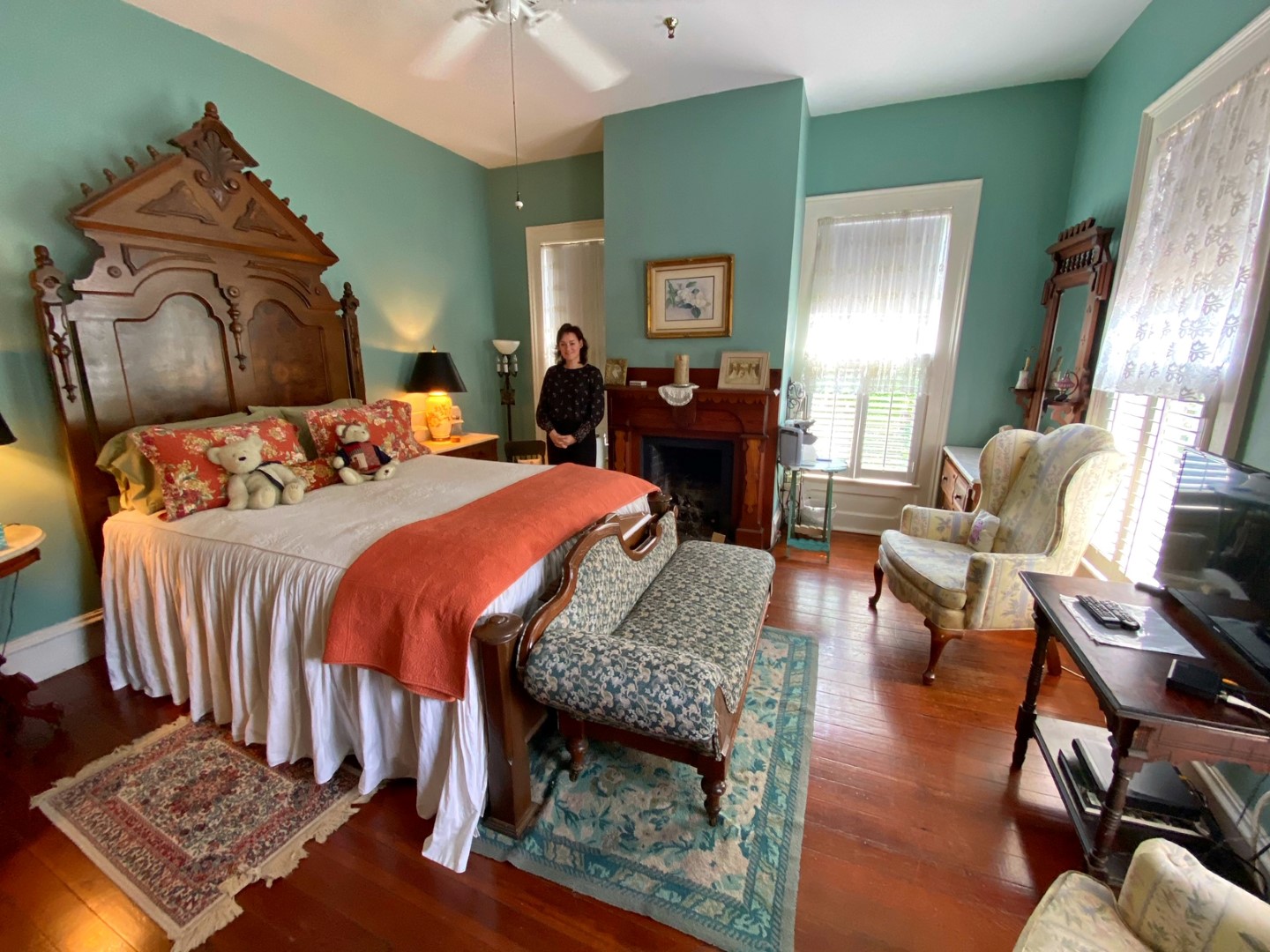 The Magnolia Suite, once the bedroom of Emmet and Mary Baird.
Yours truly in the photo. 2021
The Magnolia Suite, once the bedroom of Emmet and Mary Baird.
Yours truly in the photo. 2021
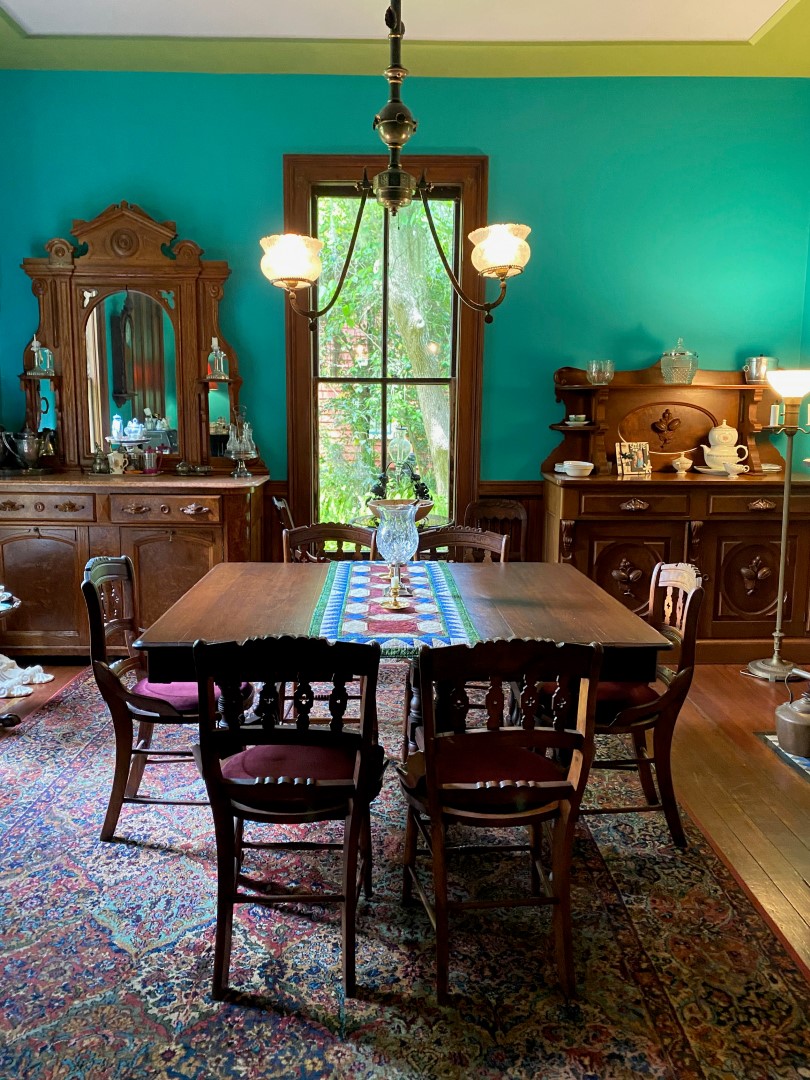 The dining room.
P Marlin 2021
The dining room.
P Marlin 2021
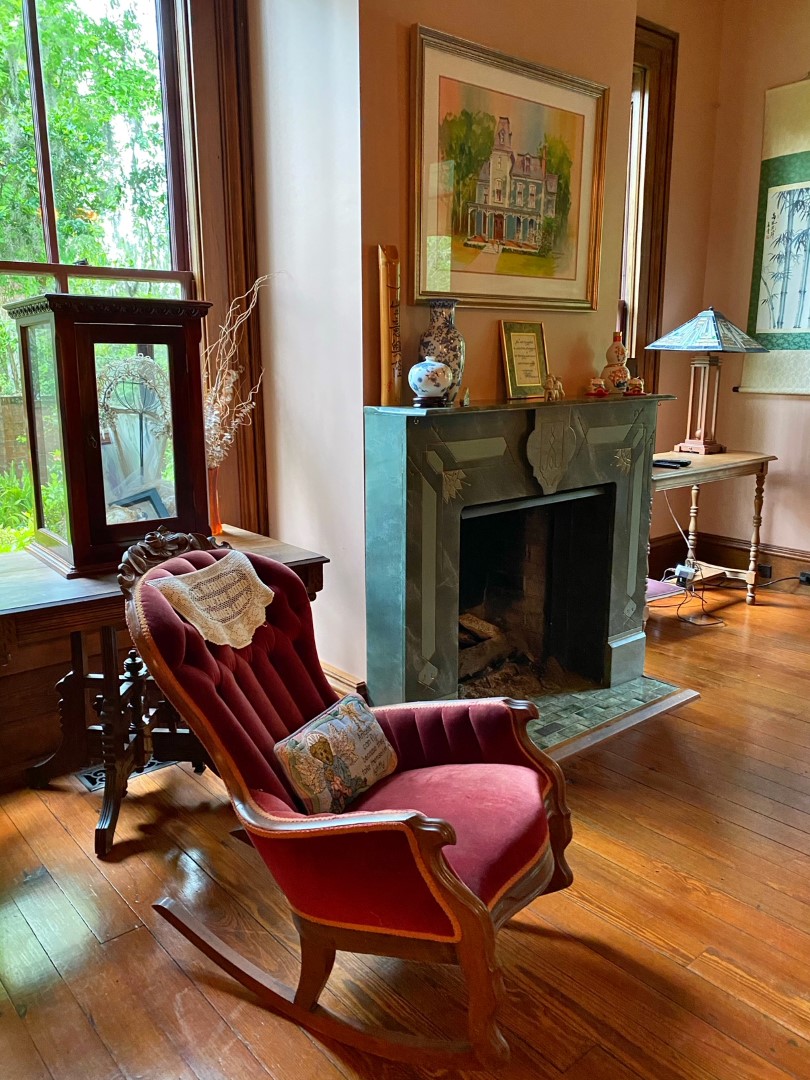 The Gentleman's Parlor. This mantel piece
has been recreated to match the original which was
torn up when a prior resident was looking for the treasure.
P Marlin 2021
The Gentleman's Parlor. This mantel piece
has been recreated to match the original which was
torn up when a prior resident was looking for the treasure.
P Marlin 2021
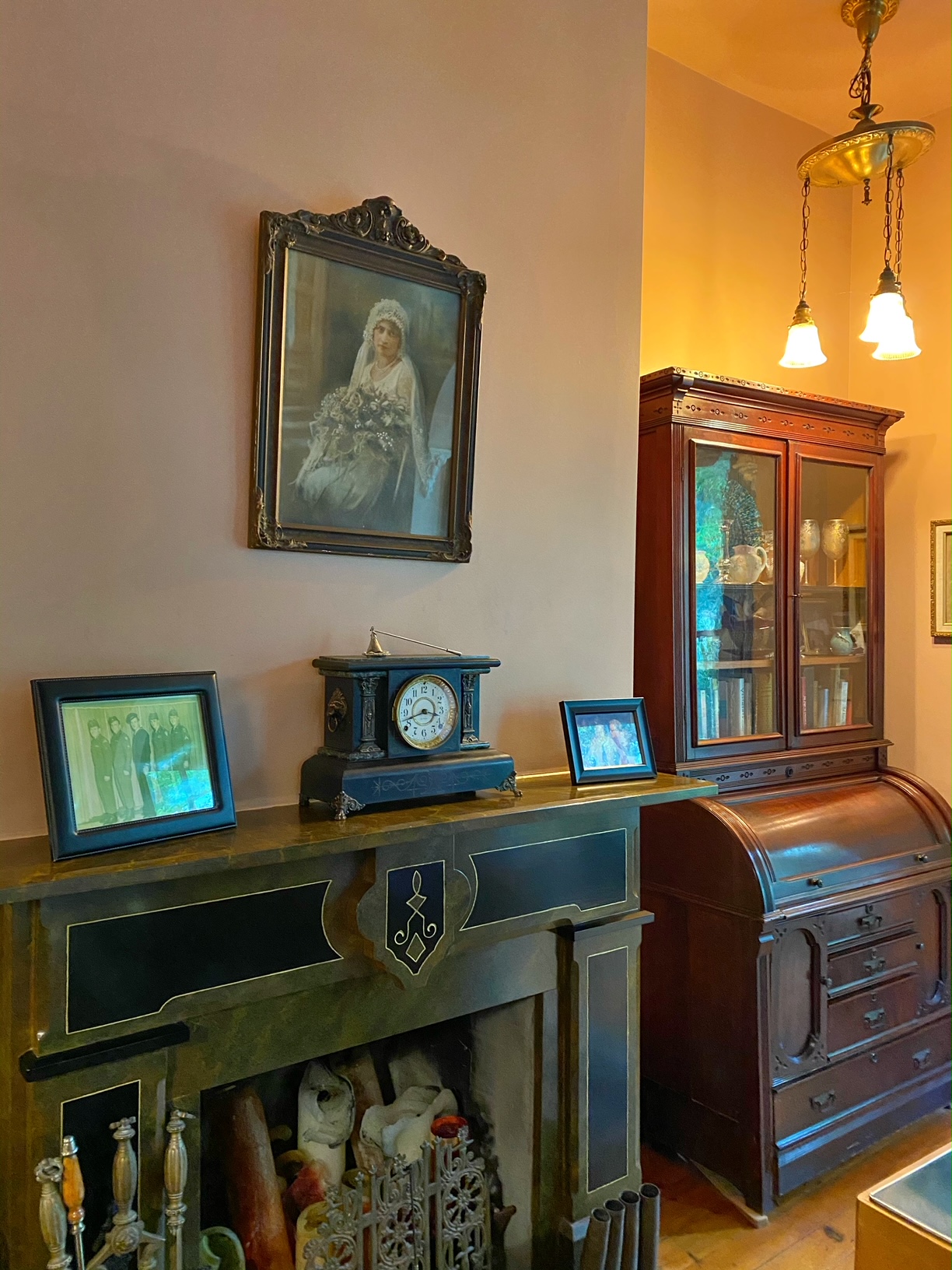 The Ladies Parlor.
P Marlin 2021
The Ladies Parlor.
P Marlin 2021
 Original tile on the ladies parlor fireplace.
P Marlin 2021
Original tile on the ladies parlor fireplace.
P Marlin 2021
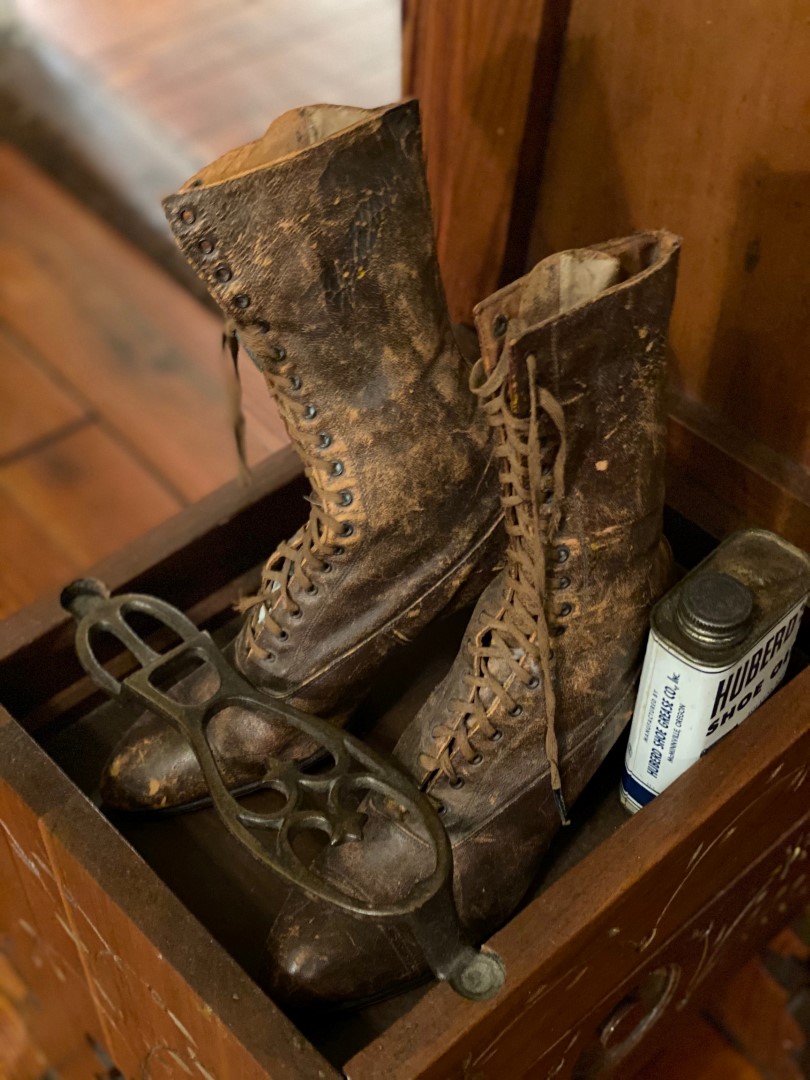 First floor display.
P Marlin 2021
First floor display.
P Marlin 2021
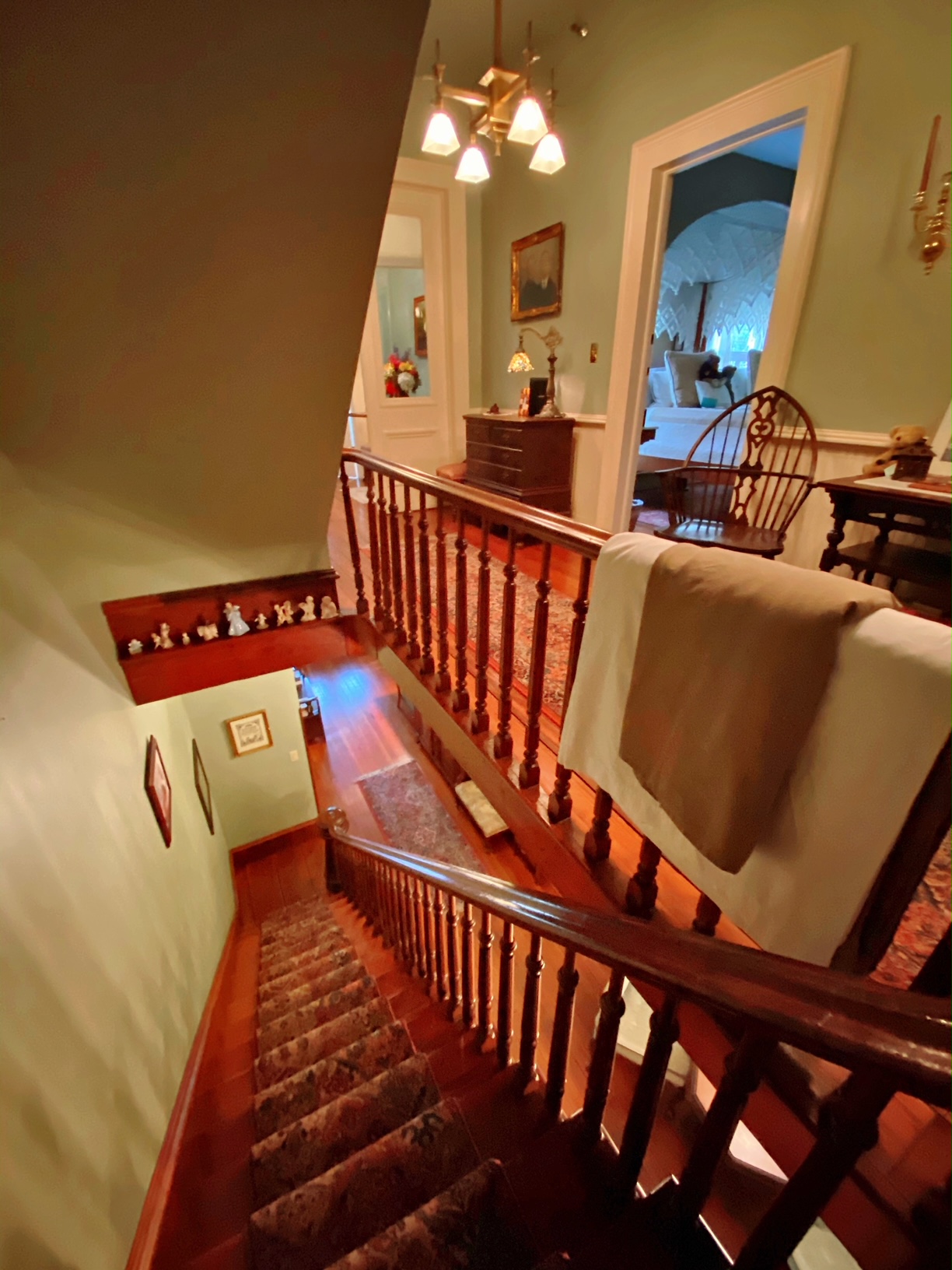 Stairway to the upstairs. The light fixture
was originally located in the ladies parlor (see in photo of flower girls above).
P Marlin 2021
Stairway to the upstairs. The light fixture
was originally located in the ladies parlor (see in photo of flower girls above).
P Marlin 2021
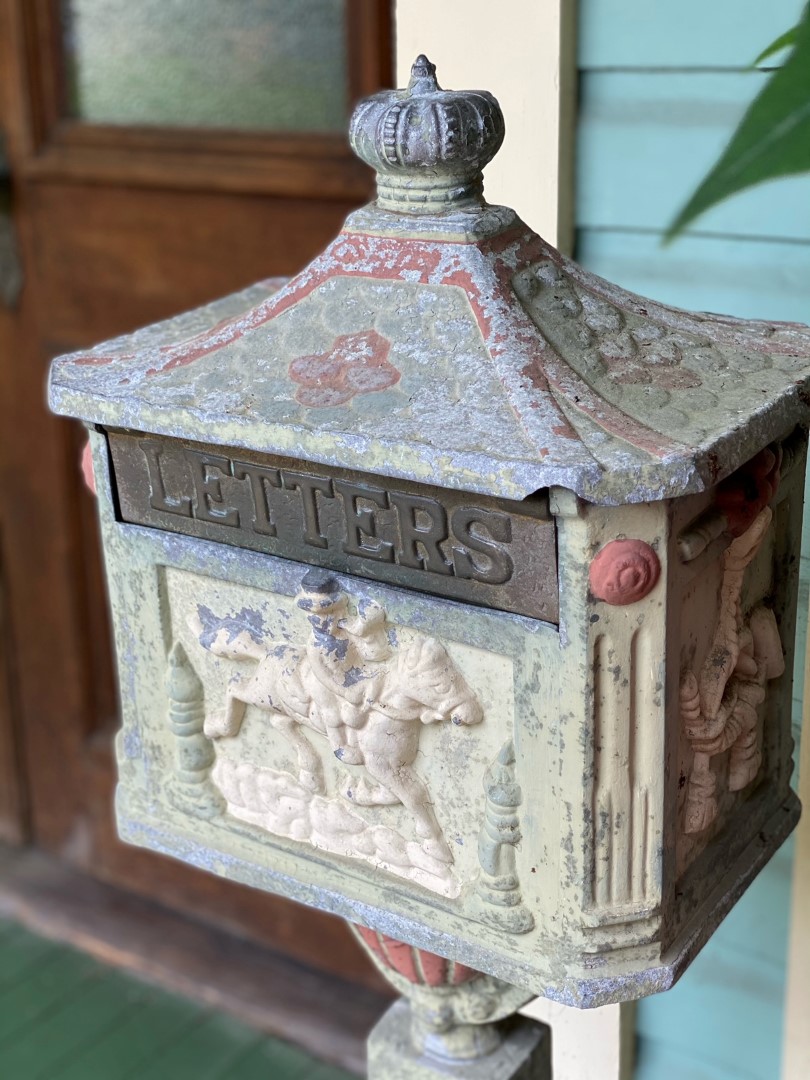 Front porch.
P Marlin 2021
Front porch.
P Marlin 2021
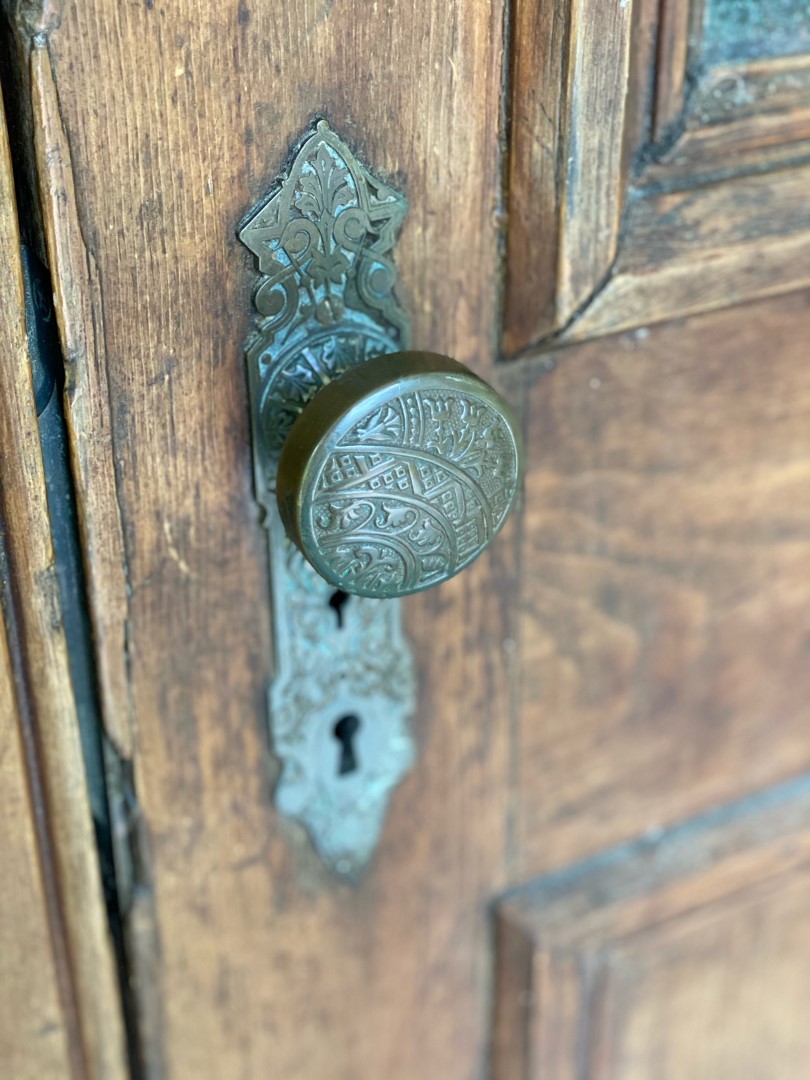 The original entryway.
P Marlin 2021
The original entryway.
P Marlin 2021
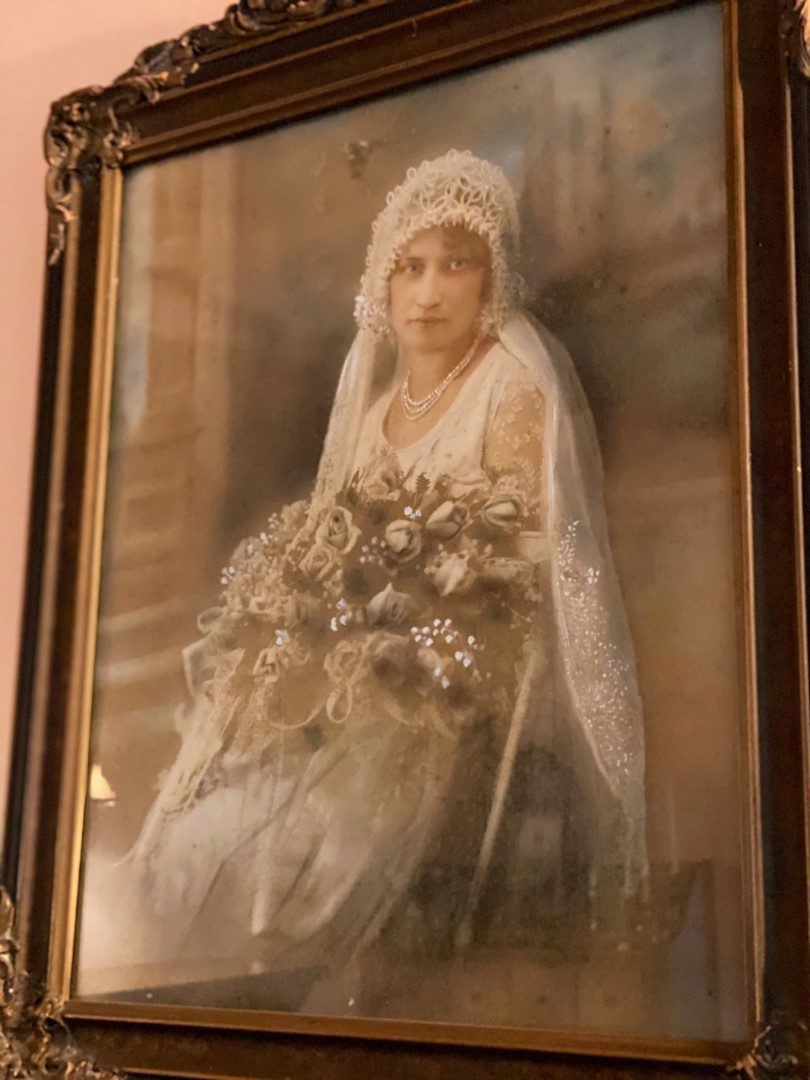 Ladies parlor display.
P Marlin 2021
Ladies parlor display.
P Marlin 2021
A special thank you to the Matheson Museum for their assistance in providing many of the resources used in this blog.
1List of deeds, Matheson Museum.
2Letter from E. Raymond Turner, Jr. to Mr. Wm. Everett Warinner of Warriner & Associates dated February 7, 1973, Matheson Museum.
3The Baird House and Family, Matheson Museum document.
4 Pirate booty in Gainesville, Matey? Gainesville Sun July 7, 2006
5History of Gainesville by Jess G David 1966
6 New search under way for buried Florida Gold Gainesville Sun November 26, 1989
7United States Department of the Interior
8The Baird House by Ben Pickard, Matheson Museum document
9The Suwannee Treasure Hunt by John Maloney
10The Baird House and Family, Matheson Museum Newsletter, February 1993.
11 The Baird Mansion Historical Review presented to the Matheson Historical Center May 8, 1995, compiled by Cindy and Joe Montalto, edietd and assembled by Debra Childs
12 Shackleford-Baird Wedding Solemnized The Daily Sun June 23, 1915 Gainesville, Florida
13 How We Began; Part 1-Moving Out; How We Began; Part 2-Spreading Our Wings; How We Began; Part 3-Coming Home